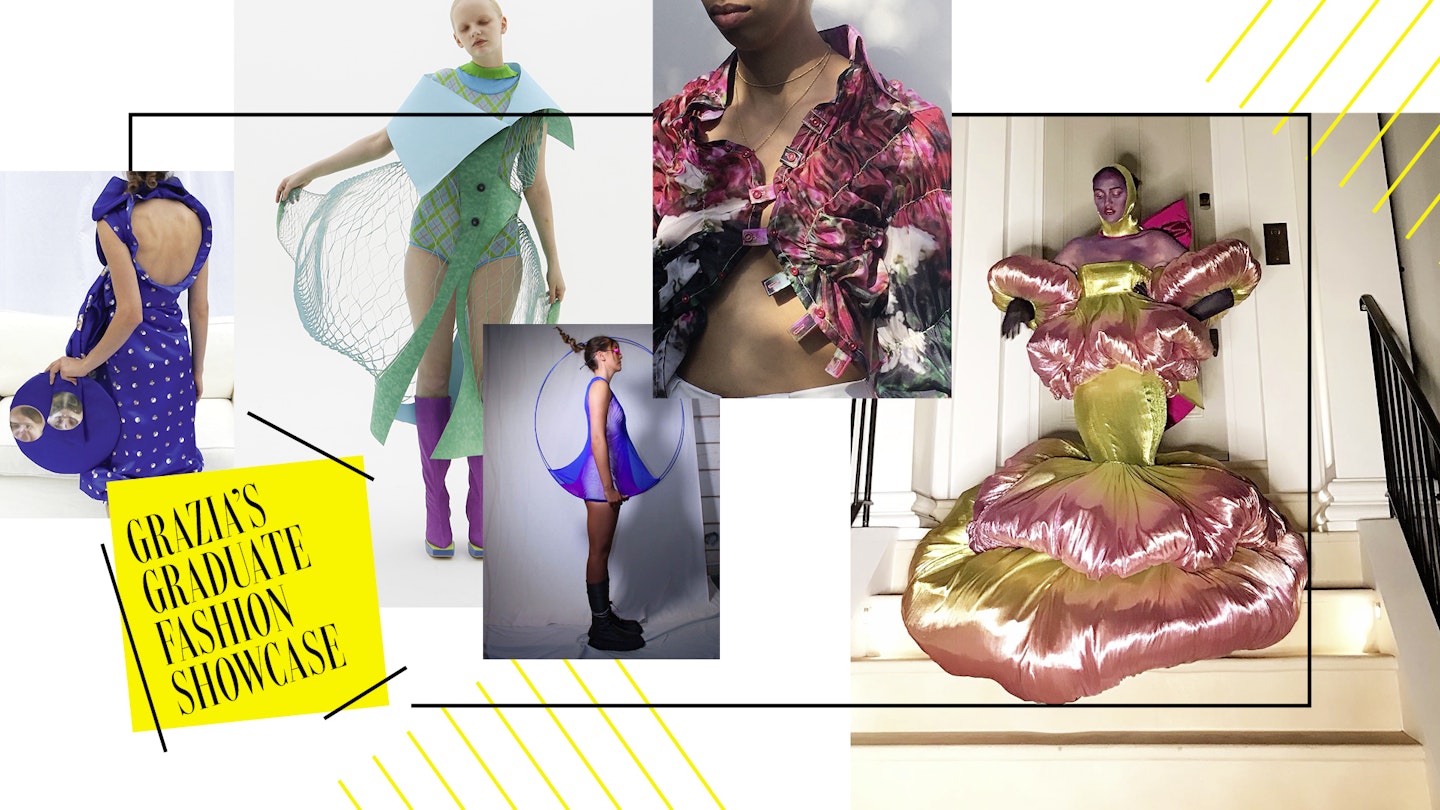Central Saint Martins' alumni is a fairly intimidating list of names, especially for any budding fashion designer on their first day at the famous school. Most of you know the names: Alexander McQueen, John Galliano, Stella McCartney, Christopher Kane, Phoebe Philo, Richard Quinn, Sarah Burtonand Riccardo Tisci, hence why it has earned a reputation as one of the very best institutions at which to study fashion in the world.
Even now, stories of those students' final shows have become fashion folklore – McCartney roped in her famous friends to help model her designs and they just happened to be Naomi Campbell, Kate Moss and Yasmin Le Bon, while McQueen's 1992 graduate collection was bought in its entirety by Isabella Blow for £5,000. Sadly, for this year's graduates, Covid-19 has ensured that no final shows are able to take place, forcing students to consider virtual presentations instead.
That's why Grazia is hosting its very own Graduate Fashion Showcase, presenting the talents of students from all over the country as they embark on the next stage in their fashion career. And it's worth paying close attention – after all, you might just be looking at the next McQueen.
Central Saint Martins: Class Of 2020
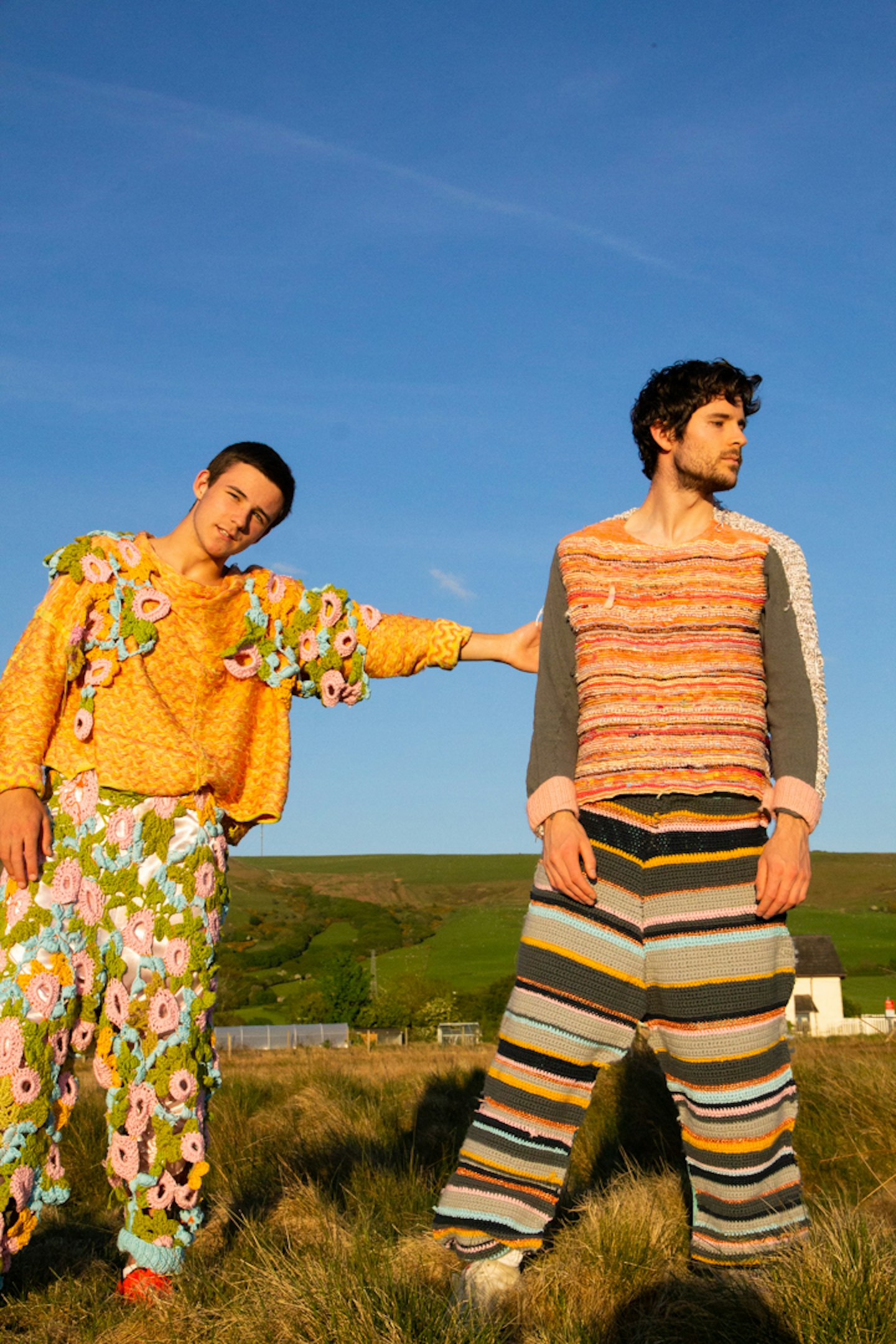 1 of 25
1 of 25Zanna Messenger-Jones, BA Fashion Knitwear
**Can you please explain your final collection?**Low waste garms for groovy individuals. Drawing inspiration from sportswear and skater silhouettes I have combined traditional techniques such as crochet and weaving with a relaxed, colourful aesthetic. Navigating my personal experiences, I created a homage to my family and the place that I grew up, through performance and spoken word.**What has been your biggest inspiration for the collection?**The inspiration behind my collection is very personal. I am profoundly deaf, raised in a hearing family, with hearing friends and went to a hearing school. The project was borne out of the reflection of my experiences as a deaf person in a hearing world. I wanted to explore the relationship with the side of myself so deeply ingrained in hearing culture and the side of myself that was slowly being revealed as I became more and more exposed to Deaf culture. I started to meet people with similar experiences, started learning to sign and slowly I found a place to belong that felt so familiar and yet so different from anything that I've experienced before. I went back home for lockdown and managed to circle back to the seedling ideas of home and family in my final images and film. A happy accident. Which fashion designers/creatives would you cite as your biggest inspiration? I found this really hard to answer! Like most creatives, I am constantly learning, moving and soaking up inspiration wherever I go, so it's difficult to pinpoint specific designers. I suppose my first inspiration was my Gran, who taught me to knit and sew at a young age. She would tell me stories of how she would go dancing with her friends and if she didn't have anything to wear she would just whip up a shift dress and with a healthy dose of hairspray on her beehive hairdo, she was on her way. I love the idea that, like my Gran with her shift dresses, you can just use what you already have lying around and create something entirely new from it. Since being exposed to the fashion industry I've been inspired by several designers, sculptors and photographers, but on the forefront of my mind is Craig Green, who has helped me to see that in a typically serious industry, you can still be playful and experimental, forming your own aesthetics. What do you think fashion will look like in 10 years? There's been a positive shift towards sustainability in new designers and this has started to infiltrate the bigger household names and I believe that the industry is headed in a positive direction. Coupled with the changes triggered by Covid-19, I hope that in 10 years, the industry will have slowed down, with a greater emphasis on producing clothes that last longer, with fewer seasons, made in safe working conditions and using materials that are kinder to the planet. What's been your highlight during your time studying at CSM? The highlight would be the people that I have met while studying there, I've been surrounded for 4 years by hardworking, dedicated people from all over the world who I would spend very long days and nights working together. Fashion gets a bad rep for overworking people, which is true, but CSM has shown me that we also have the ability to form amazing, creative support networks within it and I plan to carry these values throughout my career. What's your ambition now you've graduated? I'm quite happy to see where life takes me, this pandemic has thrown me into uncertainty and I'm not sure where I'll be even in two months. I'd love to have the opportunity to join a brand and keep creating and do what I love.
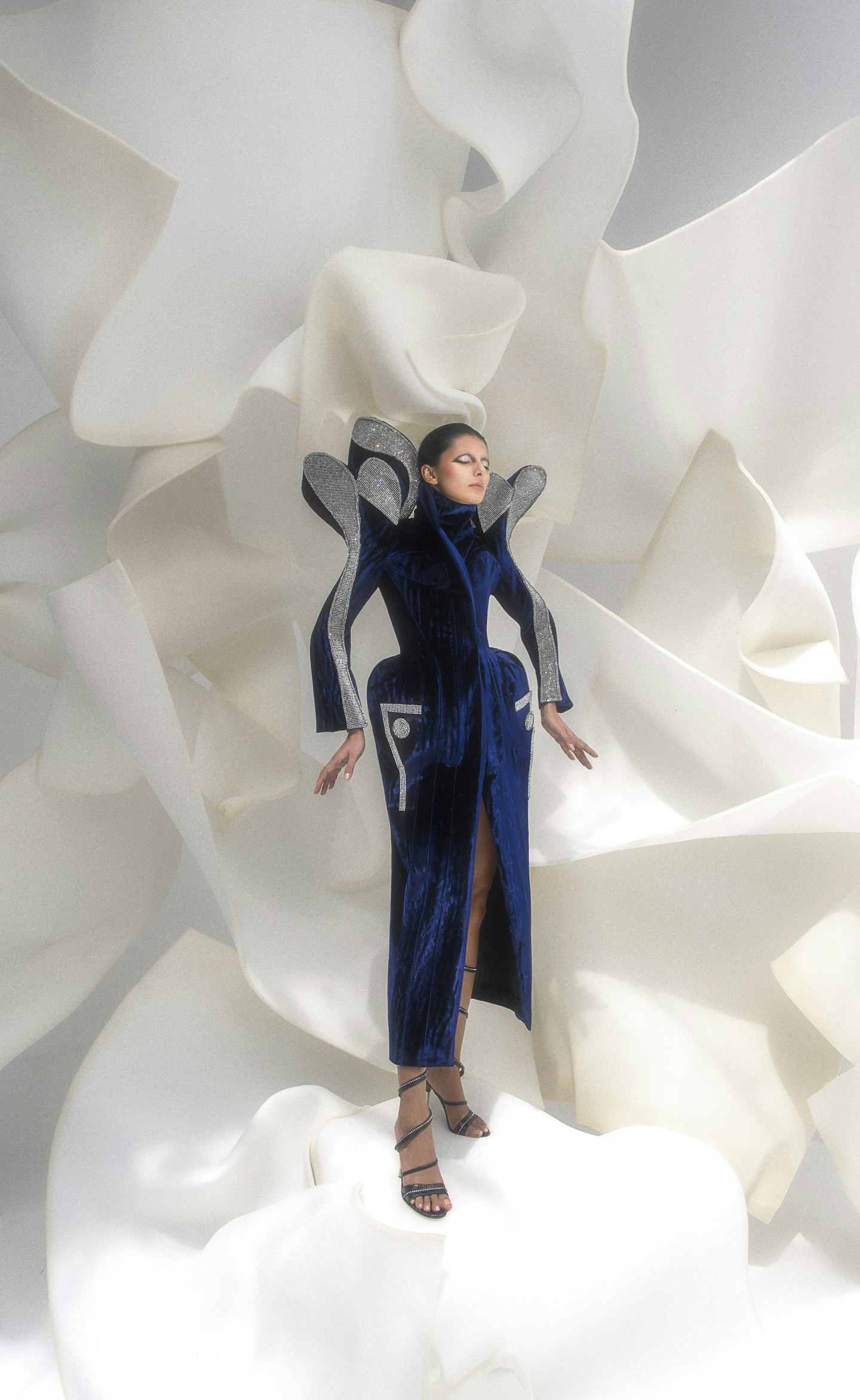 2 of 25
2 of 25Andrea Brocca, BA Fashion Design and Marketing
Can you please explain your final collection?"Senanayake" is based on my mother's opulent and unknown past, creating a fantasy of who she was in the eighties, where she comes from and who her family was. I researched and interacted with my Italian, Sri Lankan and Middle Eastern heritage to create a Haute Couture-inspired vision born from my multi-cultural identity. What has been your biggest inspiration?My motherWhich fashion designers/creatives would you cite as your biggest inspiration? Charles James, Madeleine Vionnet, 80's Yves Saint Laurent, Decarnin for Balmain, Theysken's Debut for Rochas, Boldini, Da Vinci, Bocklin.**What do you think the fashion industry will look like in 10 years?**Sustainability will be at the forefront. Hopefully, fast fashion will lose its commercial dominance, and a focus on craft and quality will return.Fashion will adopt a circular model in production such as re-appropriating unsold stock; something Patagonia is already doing. And the secondary market will flourish with dominant platforms selling vintage and second hand goods. **What's been your highlight during your time studying at CSM?**Sociological discoveries. **What's your ambition now you've graduated?**To find the platform, funding, space and time to develop my brand so I can continue innovating technical ways of creating garments and merging my cultures.
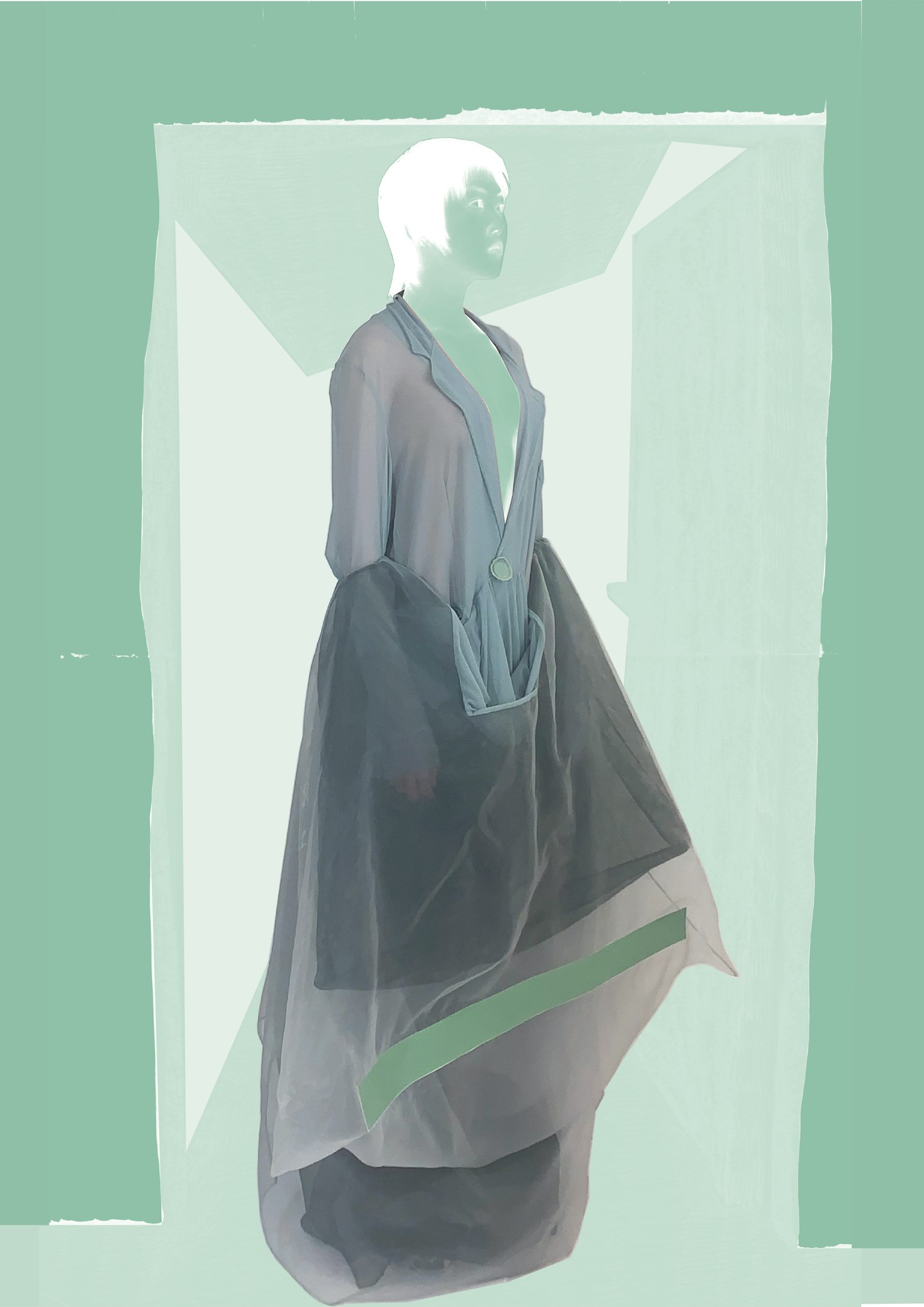 3 of 25
3 of 25Bihan Lin, BA Womenswear
**Can you please explain your final collection?**The intention of my collection Kodak Odyssey is to explore the connection and resulting layering between my memory and its present self. It is inspired by the memory I had in our family-owned Kodak Printing Studio.**What has been your biggest inspiration?**My family photos from the 90s and the process of developing a film photo.**Which fashion designers/creatives would you cite as your biggest inspiration?**There is no specific fashion designer, but the general fashion trend in the 90s is my biggest inspiration. James Turrell and Do Ho Suh inspired me a lot as well.**What do you think fashion will look like in 10 years?**It will be simpler because the world is already so complicated. **What's been your highlight during your time studying at CSM?**After the lockdown, I feel every day in CSM studio is the highlight.We learn from each other, and we have amazing tutors.**What's your ambition now you've graduated?**My goals are to do an MA in CSM and to have my studio, which is not all about fashion. Not sure if I can survive.
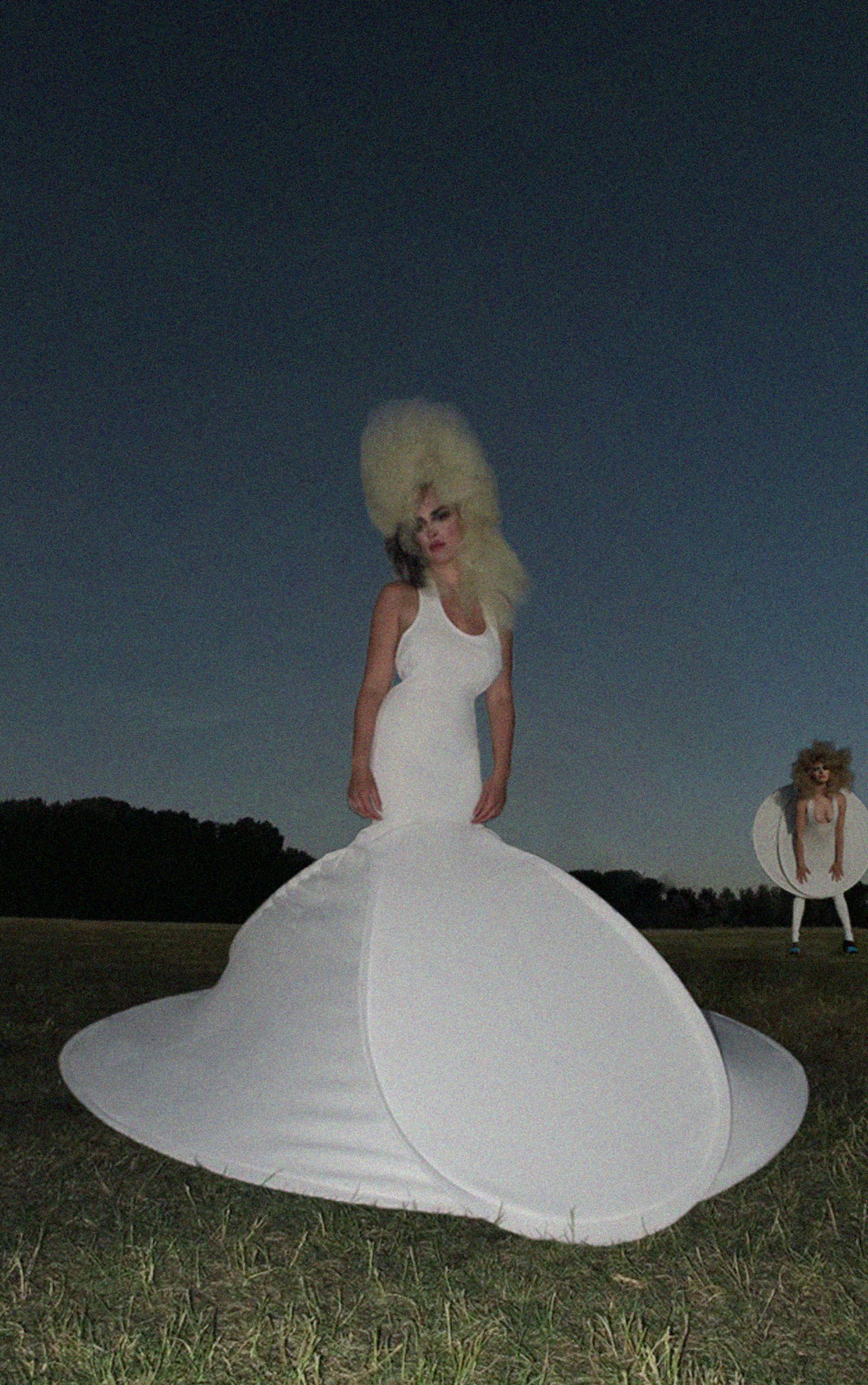 4 of 25
4 of 25Bradley Sharpe, Ba Womenswear
**Can you please explain your final collection?**My collection 'The Crowd Is Wild Tonight' prepares you for 'future mischievous endeavours' using outdoor materials, tent technologies and upcycled fibreglass tent poles. The collection acts as a landscape for waiting opportunities. After working as a barman in a sex club beneath an estate agency in Soho, I wanted to juxtapose the relationship between 18th century courting rituals against the 21st century minute mindset I have experienced.**What has been your biggest inspiration for the collection?**My inspiration usually comes from an experience or a feeling; working at the sex club basically became an opportunity for me to be paid minimum wage to research for my collection. I saw it as a moment for me to actually get out of the studio and not necessarily think about clothes but just get caught up in the feeling of what the collection could become to its audience. I also looked back on festival culture and the times I have spent in a tent. I realised that the first time i had gone to a festival was really the first moment where I felt like an adult. **Which fashion designers/creatives would you cite as your biggest inspiration?**Film has the biggest influence on my work. I was looking at James Bidgood's 'Pink Narcissus' which is this beautiful art film which illustrates the rituals of cruising. A young man lures men off the street into his apartment and innocently transforms them into images of his own fetish and imagination. **What do you think fashion will look like in 10 years?**Hopefully a lot better and more considerate towards this huge planet we all live on. I definitely think also that the pandemic could've had a positive influence on the industry. It was almost like an opportunity for everybody to test out being remote. Although I can safely vouch for the fact that it is almost impossible to resolve a graduate collection in your tiny East London bedroom!**What's been your highlight during your time studying at CSM?**The best thing to come out of CSM for me is definitely the network you come out of there with. We were all spending over 12 hour days in the studio together. We became a really (unexpected) eclectic family who essentially just look out for each other. It's probably difficult to understand for anybody who doesn't or has never studied fashion before that it can be really difficult and you can spend half of your time in your head over something. Having a support network definitely helps maintain your own sanity. **What's your ambition now you've graduated?**I just want to keep moving forward with different special projects. I wanted to start my own brand as soon as I graduated but what with the pandemic and everything going a little backwards, I really want to continue spending time pushing my aesthetic forward and refining my thing before I fully go into it. Other than that, if I were to get offered a job as the next Sandy Powell, I absolutely wouldn't say no.
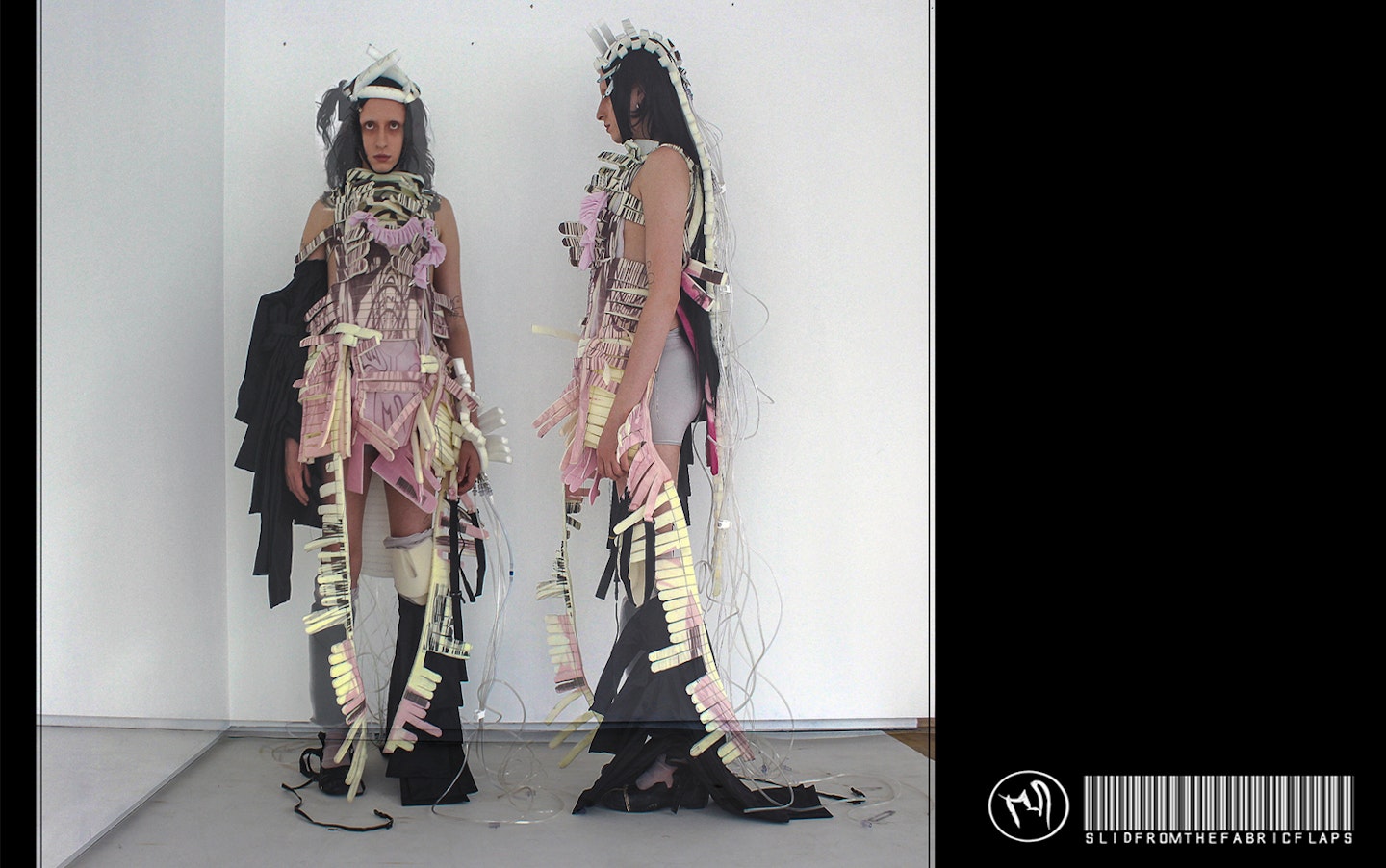 5 of 25
5 of 25Slid Needham, BA Womenswear
**Can you please explain your final collection?**Physical embodiments of the 'Trans' experience, societies longing for the compartmentalisation of our bodies both pharmaceutical and pornographic.The machine's dissection of the hyper feminine, an overly saturated and overtly-fetishised target.'Biology is no longer destiny'.**What has been your biggest inspiration for the collection?**My work is autobiographical, I find it hard listing inspirations however here are a list of words/feelings I had whilst making the collection
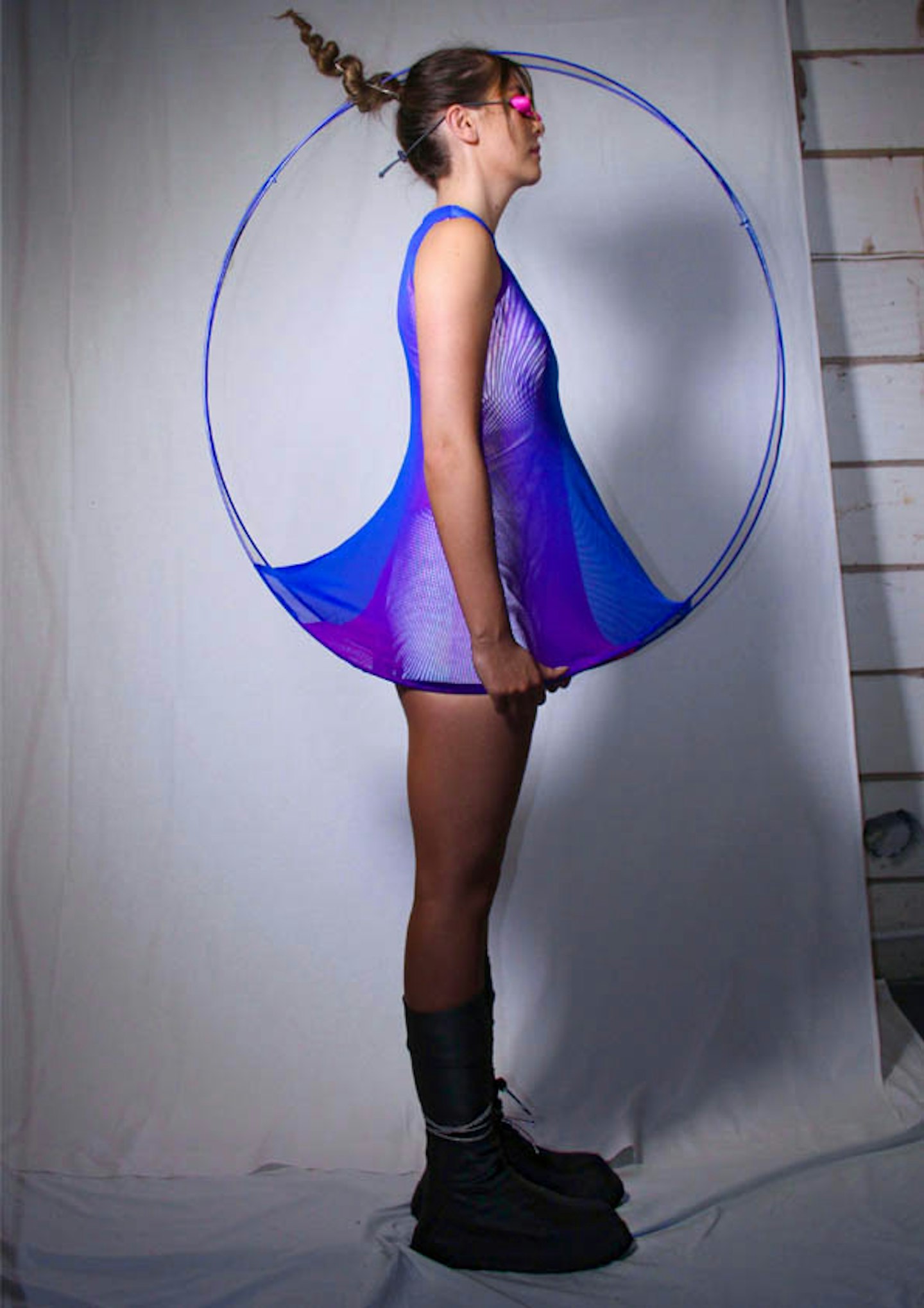 6 of 25
6 of 25Esmé Woodruff, BA Womenswear
Can you please explain your final collection? I wanted to design garments that are multidimensional, fusing both our physical and digital identities. The collection showcases a series of unconventional patterns that move and shift on the body, that have the ability to adapt and change once captured in the digital realm. Dressing the in-between. **What has been your biggest inspiration?**I have always been fascinated by how people present online... self-expression doesn't solely exist in the clothes we wear but In the way we are online . It's an ever-changing image of one's self where we are constantly adapting to create an elusive, exclusive lens into the world of you, curated by you. It's impossible to ignore online presence in fashion now. It plays such an important role in how we view fashion, how we view ourselves and others in 2020. Which fashion designers/creatives would you cite as your biggest inspiration? Peter Sedgley and visual artist Polygon who I discovered on Instagram.What do you think fashion will look like in 10 years? We have to start thinking of more eco-conscious solutions in our approach as designers. Graduating this year, it was great to see the amount of young creatives considering sustainability in their final collection. I was incredibly lucky to have sourced a large majority of scrap fabric for my collection.Whatʼs been your highlight during your time studying at CSM? Honestly, just watching all my friends thrive and grow into the young designers we all are today. You really do go through it with these people. Itʼs a completely unique experience like no other that you share together. Whatʼs your ambition now youʼve graduated? I think designing in lockdown has been strangely empowering for me and really forced me to stand alone without the constant support of CSM's facilities. Iʼd love to be able to see the collection through to the end and finish all six looks, if not more. Iʼm really enjoying my process right now working from home in my mum's conservatory in Lancashire. Thereʼs more space here then I could ever afford in London. I think that, combined with the sudden shift in how we are solely accessing fashion online now has really made me question how imperative it is to be London-based as a new designer.
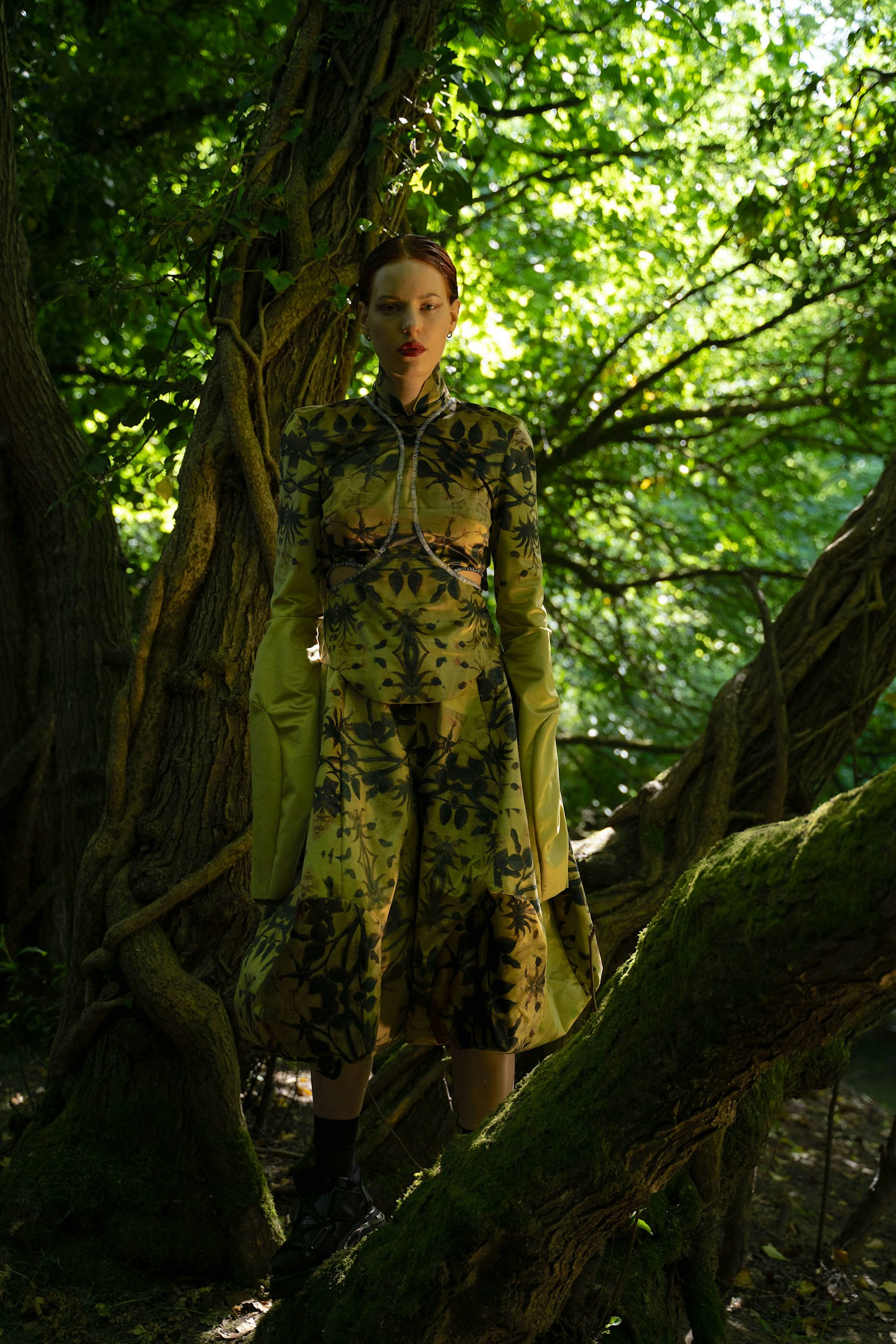 7 of 25
7 of 25Henna Malhan, BA Womenswear
Can you please explain your final collection?'When I Kissed Back' is about intimacy with oneself. It is a dark romance, where you allow yourself to question all that you thought was true, what you are and where you should be. The collection speaks of a memory which captures a moment of confusion, or state of limbo, where emotions are so intense, it's difficult to realise if it is fear or elation, desperation or exhilaration, hate or love. It is human to be complex: the collection honours these emotions. **What has been your biggest inspiration for the collection?**I'm most inspired when surrounded by nature. The prints that have been heat-pressed onto velvet were inspired by Botticelli's painting, Primavera [1470]. There is so much going on in that painting, but I was only drawn to Flora. I think because even though she was adorned with all these beautiful floral robes, there is still something low-key about her; a quiet force. The fabrics in the collection are a reflection of this; rich, broody, a perverse beauty that juxtaposes moments of intensity and calm. The thing with nature is that it consumes its space, unafraid of being seen or felt. A single flower can become a field, all with grace and beauty. **Which fashion designers/creatives would you cite as your biggest inspiration?**I feel I connect most with the works of Alexander McQueen. The exhibition, 'Unlocking Stories', revealed the amount of care that was put into each element of a garment; from research to the final product. The brand's portrayal of powerful femininity is inspiring, juxtaposing the use of heavy and soft fabrics, and experimenting with silhouettes/pattern cutting typically associated with masculinity. This attention to detail is what I aspire to have in my own work. **What do you think fashion will look like in 10 years?**There are many traditions of the fashion industry that have been questioned because of Covid-19, which perhaps are no longer sustainable. I believe in 10 years, the awareness that is beginning to rise about the negative effects of over-consumption will be more widely acknowledged, and there will be a greater desire to contribute to slow-fashion.**What's been your highlight during your time studying at CSM?**To connect with so many other talented people. I have found out more about myself as a designer and as a person and I suppose making a collection during a pandemic taught me that everything is not in our control. **What's your ambition now you've graduated?**I'd like to work within the industry to build on the experience I have and, of course, to design more clothes. That is where my heart is at.
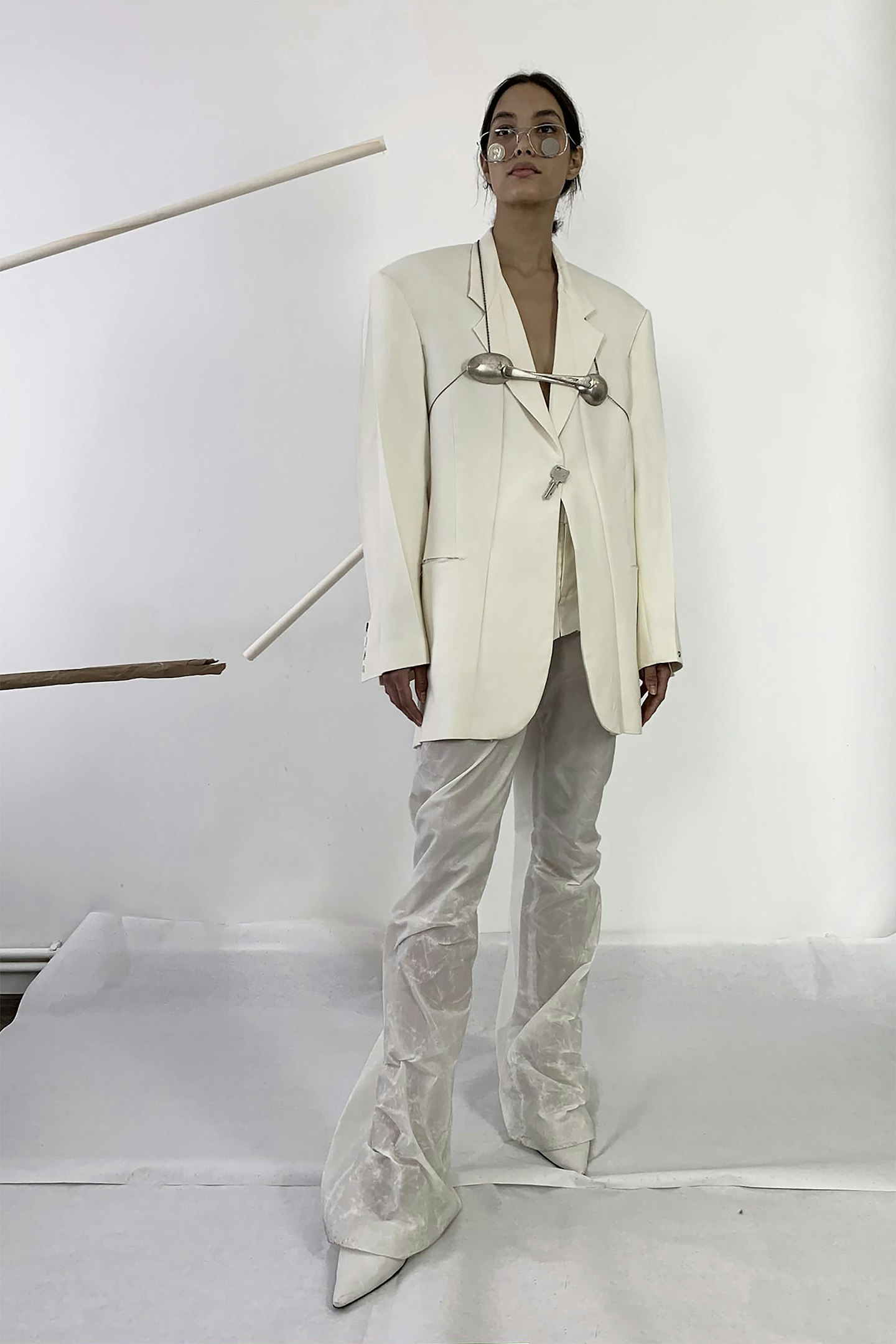 8 of 25
8 of 25Isidora Durovic, BA Fashion Design and Marketing
Can you please explain your final collection? My two main sources of research centred around power dressing of the 1980s and Adhocism, the art of solving problems using materials at hand, rather than waiting for a perfect moment or a right approach. I used men's tailored pieces as a base on which I applied several draping and textile techniques, such as bonding and waxing. The aim was to create pieces which convey the sense of effortlessness, resourcefulness and boldness in dressing. **What has been your biggest inspiration?**Inspired by the problem-solving mentality of a working woman, I tried to subvert the function of everyday objects to create hybrid accessories for 'a woman on the go'. Another source was Richard Wentworth's photography series Making Do and Getting By, in which he documents human resourcefulness on the street. The poetics and immediacy of the street inspired my silhouette developments as well as texture. I played with layering, bonding and waxing of light and crispy materials that resemble materials found on the street. Which fashion designers/creatives would you cite as your biggest inspiration? I admire the work of Ana Kras, a multidisciplinary artist from Belgrade, which is where I am from. I learned a lot by studying Margiela's early work as well as Phoebe Philo's work at Celine. What do you think fashion will look like in 10 years? The fashion industry is more than ever under pressure of moving towards more sustainable ways of operating. I hope that in 10 years we will see a change in the pace of the industry, transparency in communication, and shift towards a more circular system.What's been your highlight during your time studying at CSM? There were so many highlights of the past five years! I will probably remember working long hours in the library and the studio with my classmates the most. The incredible people whom I met at CSM are definitely the highlight of my studies. What's your ambition now you've graduated? I would like to take some time to reflect on the whole experience of studying and working in fashion in order to figure out which part of the industry I see myself in. My long term goal would be to build an independent creative practice, but It might take a few more years of learning before I make this move.
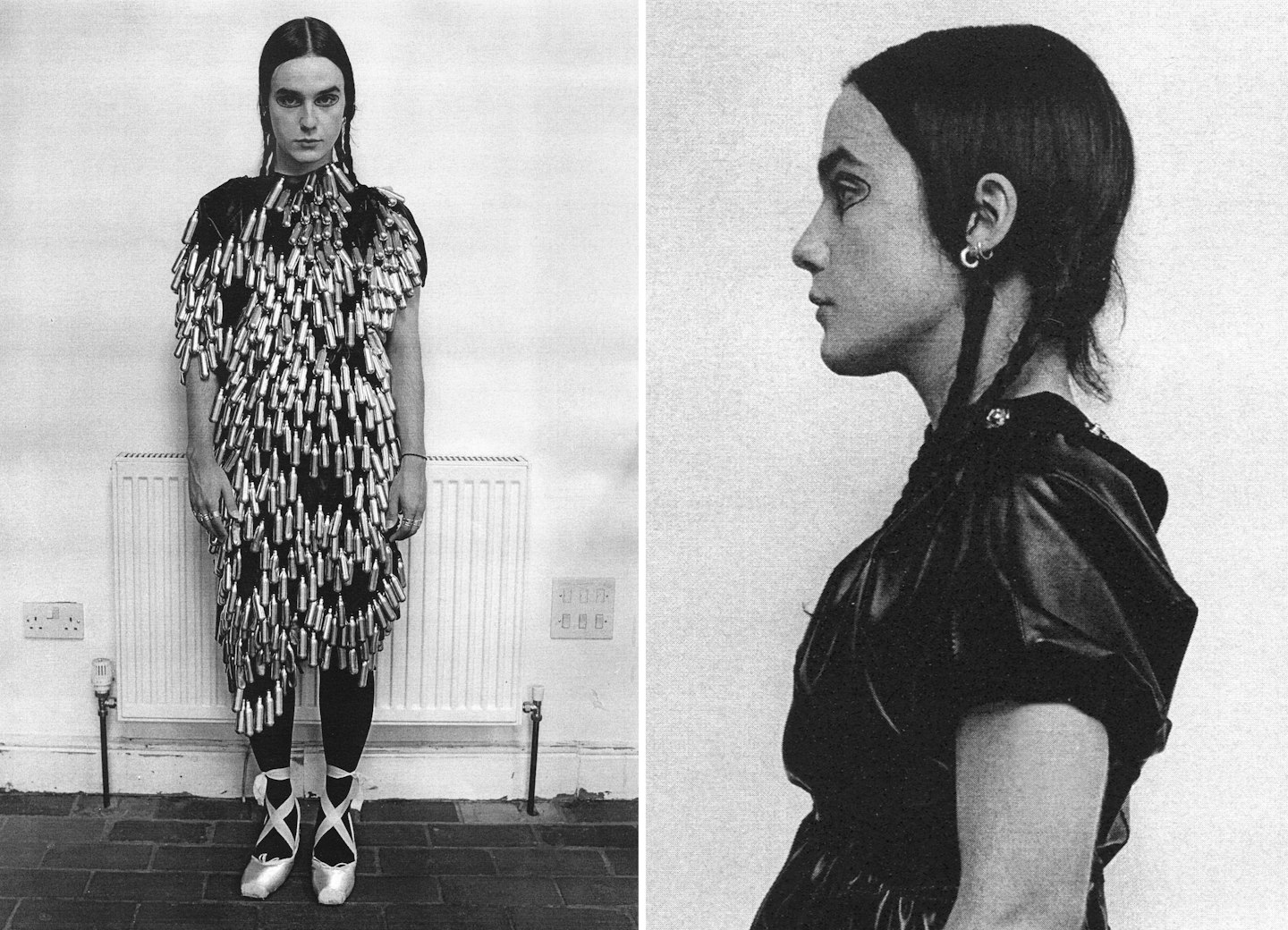 9 of 25
9 of 25Jamie Sutherland, BA Womenswear
**Can you please explain your final collection?**One of the looks from my final collection is made entirely out of toilet paper. I was partly inspired by the children's party game of wrapping someone up as an Egyptian mummy using toilet roll. This seemed like a good idea at the time, until the global pandemic took hold and all the supermarkets ran out. Toilet paper suddenly became a luxury fabric. My final collection is about the way we preserve fond memories, often building imaginary communities within them as a means of escape. But how in doing so, painful memories also remain. **What has been your biggest inspiration?**I began looking at my childhood photos – I was comfortable as the only boy wearing dresses at school. I had a carefree autonomy back then which still surprises me today. I see my childhood as a sort of time capsule of happiness, but within these idealised memories lies forgotten darkness. This realisation became the catalyst for my collection.**Which fashion designers/creatives would you cite as your biggest inspiration?**I don't have a favourite artist but I'm a huge fan of Zhang Huan, Louise Bourgeois, Ren Hang, I could go on. My parents have also been a great inspiration throughout my life; my dad is a photographer and my mum is an artist and writer. They have both hugely influenced my creative practice, although I've only begun to realise this more recently. **What do you think fashion will look like in 10 years?**I hope fashion shows and presentations become more performative again. For instance; Issey Miyake's collaboration with Cai Guo-Qiang or Shalom Harlow being spray-painted by Alexander McQueen's robots. **What's been your highlight during your time studying at CSM?**I think the best part about studying at CSM has been the people I've met. I really miss that moment of bumping into someone near the water fountain or on the stairs to the shop when you've run out of thread, small things that didn't seem important until college closed so abruptly. **What's your ambition now you've graduated?**I would really love to work for an artist and to continue making my own work at the same time, and one day to exhibit in a gallery. I'll never forget the first time I visited Tate Modern; I was twelve and my mum took me to see Ai Wei Wei's sunflower seeds. That piece really changed how I saw my future, and who I wanted to be when I got older.
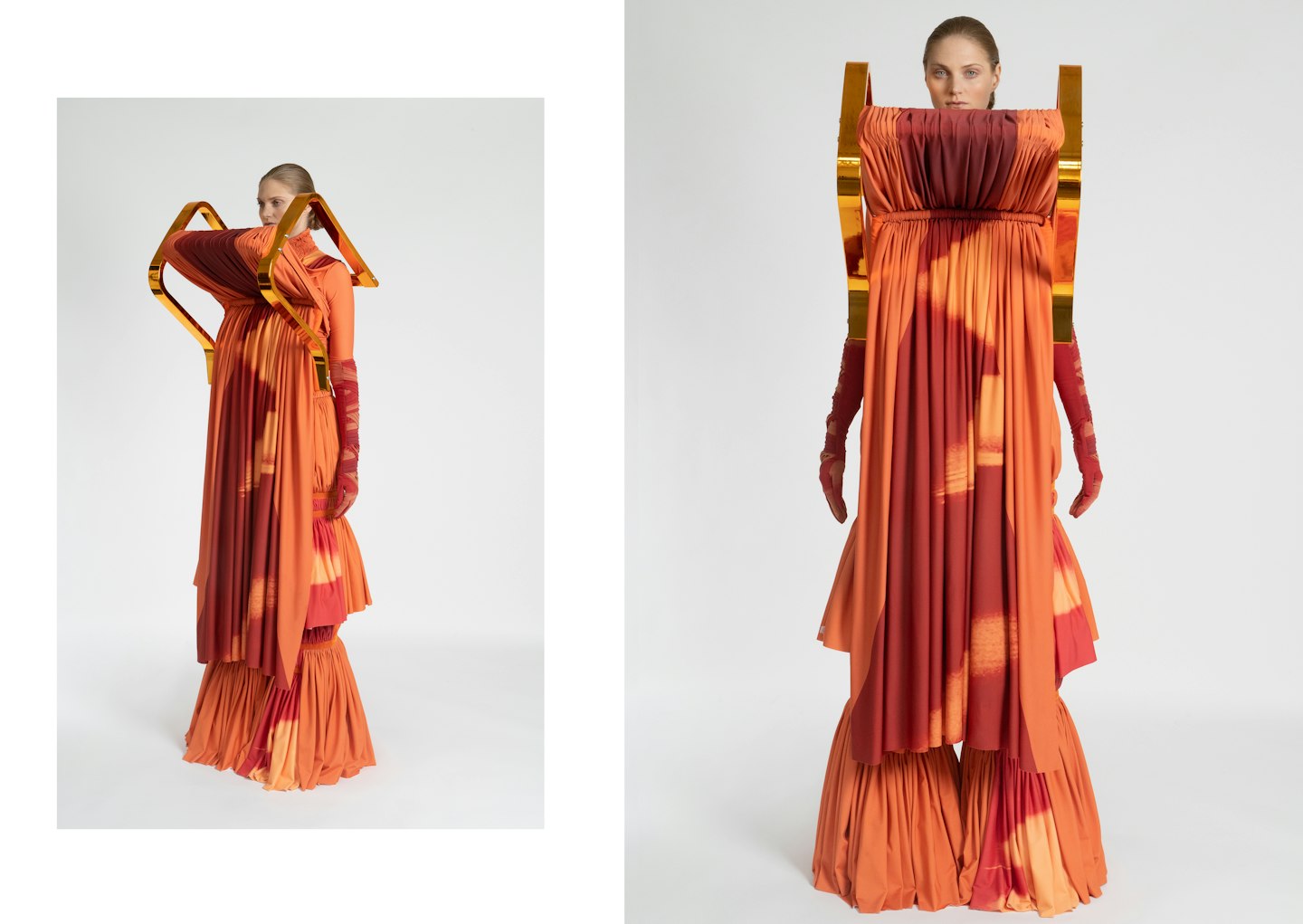 10 of 25
10 of 25Jessan Macatangay, BA Fashion Design and Marketing
**Can you please explain your final collection?**The collection is about finding beauty and power in struggle. A chair, representing struggle, is made for you to rest, but when you put in a different position in your body, you give it an opposite power which becomes heavy and painful. Everyone has struggles so the best solution is finding beauty in struggle which culminates in success and power. This result to my muse trying on a chair and finding every opening she can fit and then deconstructing the chair. The collection, starting from a big sculpture on a body and then becoming smaller on the next models, signifies that when you face a struggle, it becomes smaller and eventually becomes part of your body making you stronger, more powerful and a better person.**What has been your biggest inspiration?**My biggest inspiration is human's resilience to adapt and face to every hardship in life.**Which fashion designers/creatives would you cite as your biggest inspiration?**Rei Kawakubo has been the designer that I look up to. All of her collections always give me goosebumps and joy every time. And that is what I love about fashion.**What do you think fashion will look like in 10 years?**There will be advances in technical innovation and everyone will adapt to wearing futuristic clothing. **What's been your highlight during your time studying at CSM?**Being taught by some iconic tutors, working and studying alongside some of the most creative students and finding my voice in fashion.**What's your ambition now you've graduated?**I am planning to do an MA at Saint Martins.
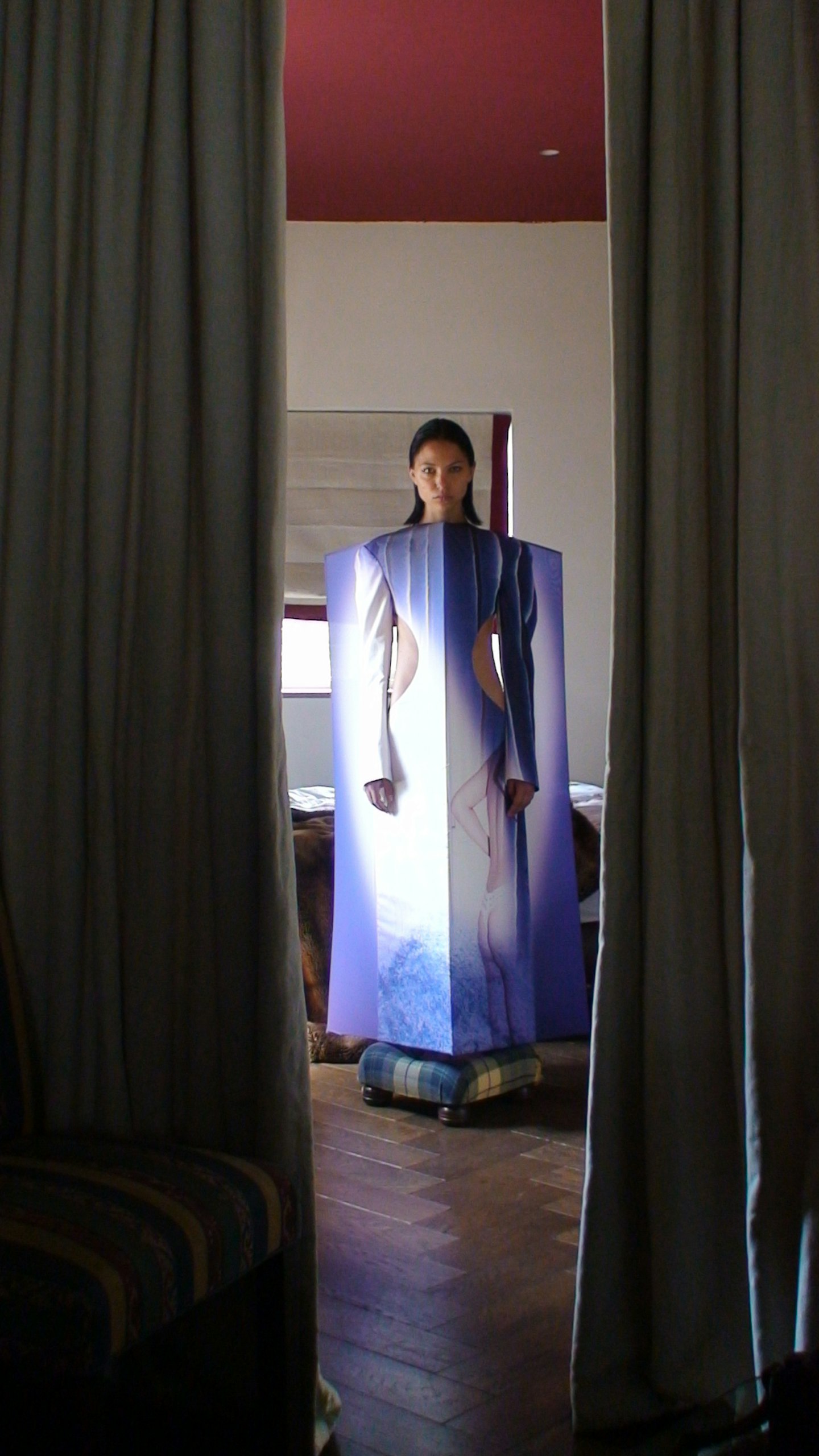 11 of 25
11 of 25Jin Xie, BA Fashion Print
**Can you please explain your final collection?**I made up an intimate space in this collection. It is a fantasized dreamscape, a 'room' scene witch you can peep inside. The nude female body is 'you', you are the audience and you are the voyeur of yourself.**What has been your biggest inspiration?**I have looked at female artists like Julie Becker and Mary Katayama. I took a series of selfies of my body from the mirror – I am viewing my own body from a safe and intimate space rather than in a public space. And also, I am looking for a new perspective to view the body through the holes or gaps on the garment.**Which fashion designers/creatives would you cite as your biggest inspiration?**I like the intense all-over print of Jean-Paul Gautier and how Chalayan expresses his concept powerfully, simply and clearly. **What do you think fashion will look like in 10 years?**I hope people will not recognise the boundary between the runway and daily wear. There might be some new technologies or new manufacturing methods that could make everything very easy to wear and practical.**What's been your highlight during your time studying at CSM?**I think my highlight has been since lockdown happened. It creates a lot of confusion and stress but it is a very special experience, especially when everyone is working on our final collection. I had to start thinking about what this collection means to me if we will not have any show. So, it is a special time that pushes me to explore more possibilities and think deeper.**What's your ambition now you've graduated?**My inspiration all comes from my cultural background and I hope I can record some special techniques of fashion from my own culture. I want to bring this idea to the MA course I am planning to do and develop those techniques.
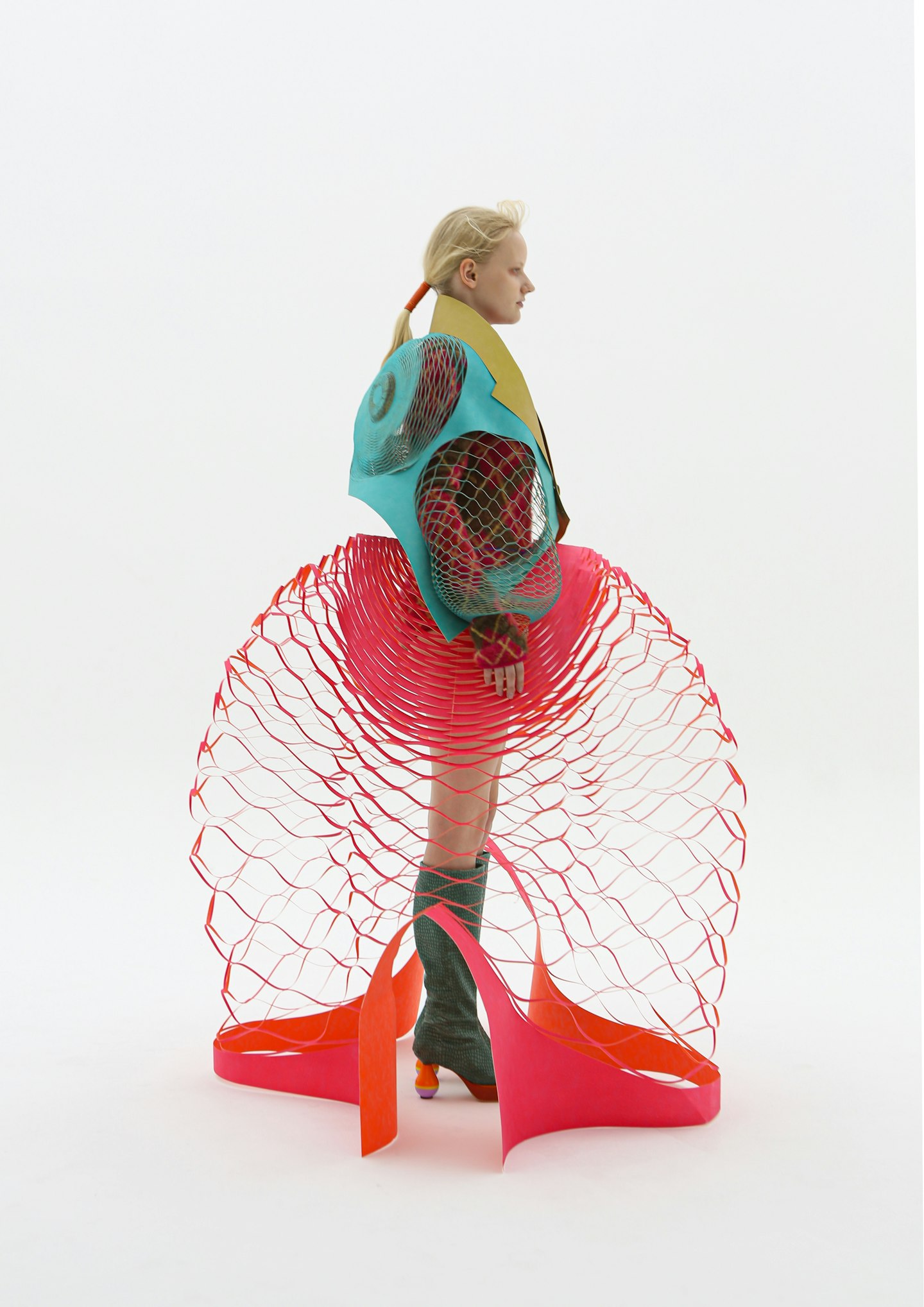 12 of 25
12 of 25Jisoo Jang, BA Fashion with Knit
**Can you please explain your final collection?**I can't explain my taste, my place without my collection of things. I found happiness completely when I piled them up. As I am very interested in various items, I have deliberated over collecting more precious and valuable things. These days, a lot of products are coming out, but I want to talk about the importance of people to think about consuming continuously and think about whether they can make the future on the Earth happy. I tested a lot of new materials to develop sustainable techniques in this collection such as zero waste pattern with laser cutting on washable paper which can be any size, bio-plastics with cornstarch and Jesmonite.**What has been your biggest inspiration?**Inspired by 'My Various' collection, I imagined six muses. Assuming that each vase was a character, I imagined their collection and matched the scent to her. They were of myself and also part of me, memory experience and happiness.**Which fashion designers/creatives would you cite as your biggest inspiration?**I'd love to say Goom Heo and Dohan Jung. They are Korean designers who are based in London.. They inspired me a lot – as friends they gave such precious feedback for my collection. I really want to thank them. **What do you think fashion will look like in 10 years?**For the future, the importance of sustainability will be emphasised more and more. **What's been your highlight during your time studying at CSM?**I can tell it's a great chance to see amazing people every day. There are so many interesting and talented people in CSM. **What's your ambition now you've graduated?**I want to build up my own label which is not just restricted to fashion – more about lifestyle and design. I really want to do another collection – I cannot stop thinking about it.
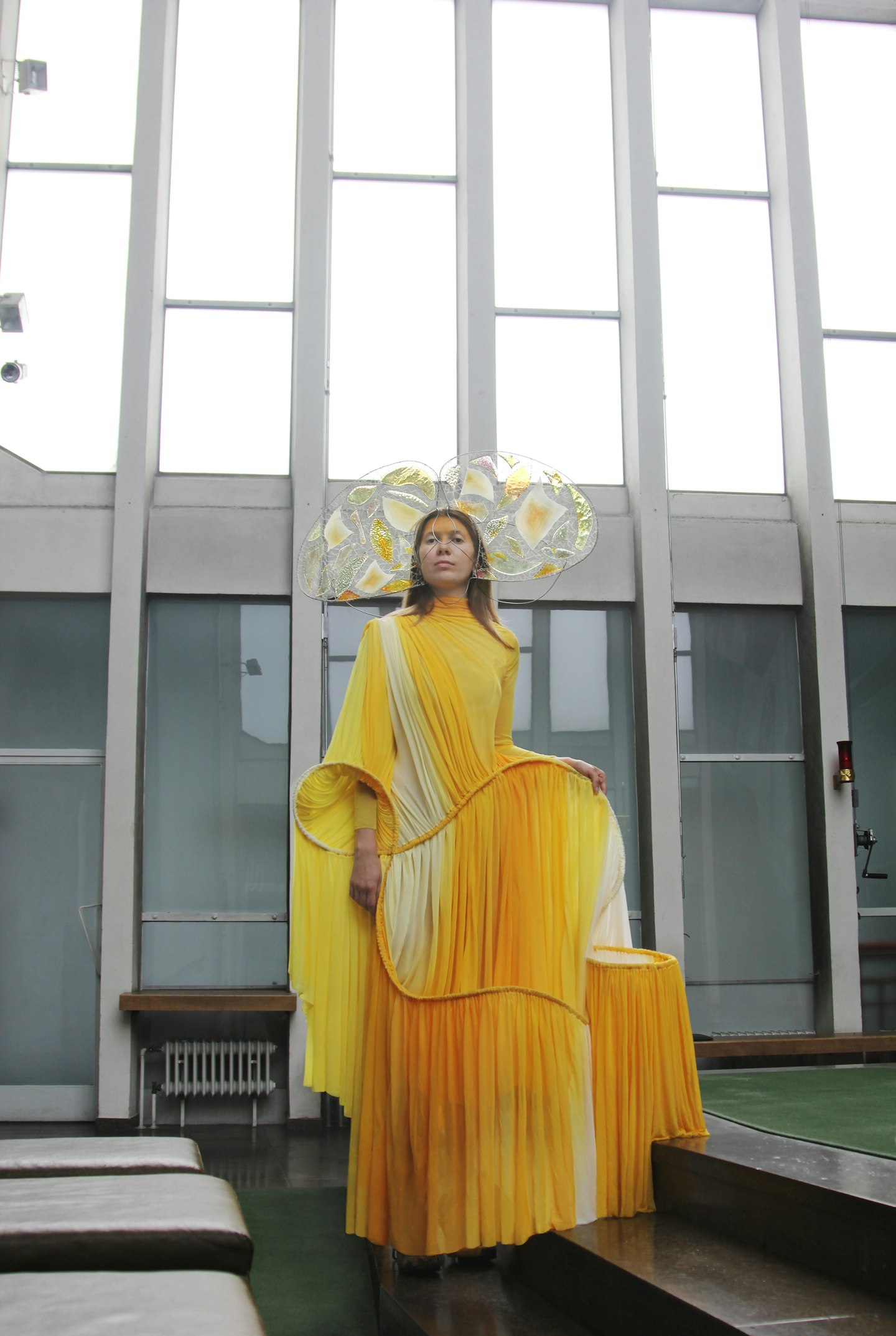 13 of 25
13 of 25Johannes Warnke, BA Fashion Design and Marketing
Can you please explain your final collection? My sustainable graduate collection Windows of Perception is based on fashion's influence on the wearers' perception of surrounding and self – the collection guides the wearer into the state of mindfulness through multi-sensory, experiential features. Each look is inspired by the meditative spirit of modernist church architecture and stained-glass window art and is reinforced by accessories which stimulate the multi-sensory perception for the wearer through sound and light. Alongside hand dying every bit in my collection, every glass shape in the headpieces is self-made and moulded from bioplastic. My sustainable process included zero-waste pattern cutting and the usage of cruelty-free silk and up-cycled textiles such as tapestry and rest stock fabric. **What has been your biggest inspiration?**The project is conceptually inspired by Maurice Merleau-Ponty's book Phenomenology of Perception and is visually inspired by first-hand research of sacred modernist architecture in Germany: elongated concrete walls vs. delicate stained glass windows. As atmospheric places of silence and human connection, brutalist church buildings express the peacefulness one might long for when following mindfulness trends as the answer to visual and social overstimulation on social media. Now in times of isolation and our dependency on virtual channels, the yearning for a meaningful haptic and sensory connection to environment and humans has become more relevant than possibly ever before. **Which fashion designers/creatives would you cite as your biggest inspiration?**A fashion revolutionist without intending to be: Pina Bausch, my childhood idol. The viewer is taken on stage and into the clothes by her sense stimulating way of merging scenography, costume and dance into one harmony. Through dance, beige dresses turn with every movement into brown mud-soaked dresses while a red dress in water merges into a transparent second skin, transforming the look and feeling of the dancer in the clothes. For this collection, in particular, Madame Grès was an inspiration too and her ability to shape and proportion the body through the language of draping and gathered lines. **What do you think fashion will look like in 10 years?**Less is more is my hope. Less waste and fewer shows. My hope for fashion in ten years is the realisation of sustainable and reduced ways of production and a more timeless view on design. It should be either art or truly functional design with maximum two seasons per year, anything extra could be done just virtually for example to reduce waste and change the overconsumption consumerist mindset. It would also benefit companies economically to reduce overproduction. Sustainability and timelessness should be the general new sense of luxury. **What's been your highlight during your time studying at CSM?**My biggest highlight was getting accepted to the BA course from Foundation. I remember having the craziest celebration with the entire group in the park, with a lot of them graduating this year I especially look back to that moment and night with the greatest nostalgia. Generally, the continuous greatest highlight was to be guided by very supportive tutors and to have made friends with incredibly talented creatives who I will work with after graduation on future projects. **What's your ambition now you've graduated?**My ambition is to explore the multidisciplinary boundaries between fashion and other art forms, especially dance and painting in planned future collaborations with choreographers and artists. I also plan to launch a product line with classmates on sustainable, functional products that humorously enrich the everyday. In my view, sustainability and mental health are two major general points the future fashion industry has to face, so I would love alongside working on sustainable projects also engage as an educator for students on how to handle stress and competition, thereby helping fashion to become a more social place, too.
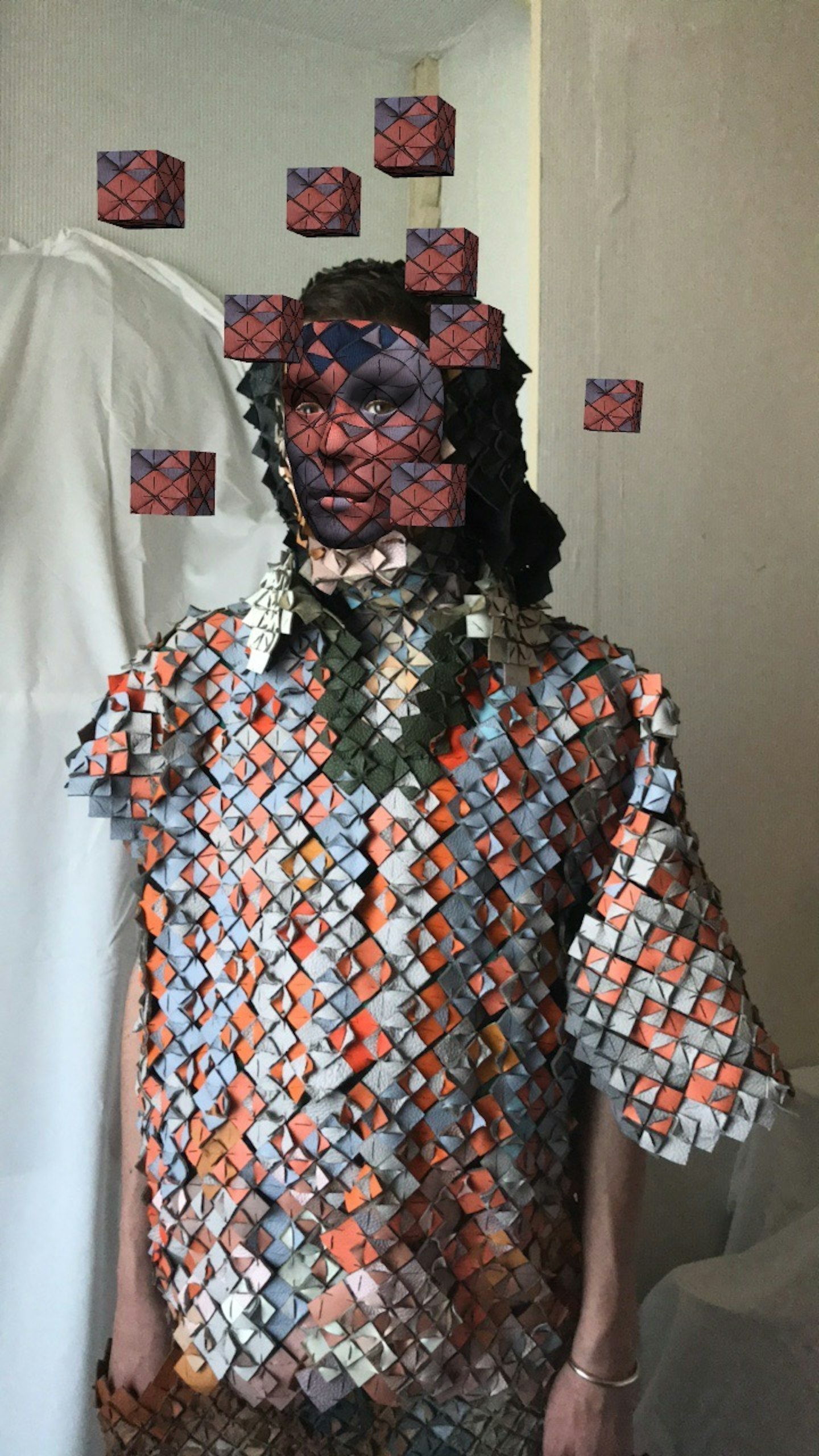 14 of 25
14 of 25Mathilde Rougier, BA Womenswear
**Can you please explain your final collection?**The collection addresses damaged data and it's restoration as a form of creation. The collection's aesthetic is based on a personal digital archive of garments modelled after the system of museum donations. The archive is manipulated digitally through pixelation, 3D scanning and AI. The collection uses modular construction, where leather sample books, scraps, and damaged hydes are cut down into tessellating modules so a maximum of the material can be re-used. These pieces are slotted together allowing for them to be repositioned like Lego and acting like pixels on a grid, allowing for the garment to have boundless iterations of itself using the same materials. The second process is based on the re-use of LDPE plastic packaging from the fashion industry. The material is built around the form; parts can be cut off and bonded back into each other, minimizing material loss. Neither of these use sewing, making the garments built for disassembly and recyclable as material unity is conserved. The third process is based around the upcycling of 100% cotton hotel sheeting. These garments are sewn using 100% cotton thread conserving material unity. They are also designed using no waste cutting and dyed using China ink. The last process uses augmented reality to plane track the garments, in order to evolve their shape in the digital plane. **What has been your biggest inspiration?**The collection stems from on an observation: what waste do we produce as an industry? The solutions I have found and the aesthetic that inspired the collection come from digital systems and garment restoration. **Which fashion designers/creatives would you cite as your biggest inspiration?**Celia Pym for her beautiful work on visible mending and restoration as creation and Robbie Barrat for his incredible work around fashion and AI. **What do you think fashion will look like in 10 years?**In ten years, fashion is going to have to be sustainable. We are going to observe new ethical models, tech innovations and production systems focused on eradicating waste and producing garments that last, by people paid fairly. The other major evolution the fashion industry is going to go through is digitization, in ten years we're all going to have virtual accessories, AR t-shirts and watch shows in virtual reality. What's been your highlight during your time studying at CSM? The highlight of CSM is the people! Hands down, the people. CSM is a diverse place where so much of what you learn comes down to the conversations you have with your tutors, your classmates, at the SU bar with other courses. CSM fosters a positive sense of emulation. **What's your ambition now you've graduated?**After I graduate I want to continue working on sustainability, finding new solutions, and improving on the ones I have developed. I also want to continue working on the digital skills I've developed, I'm only at the beginning of that journey!
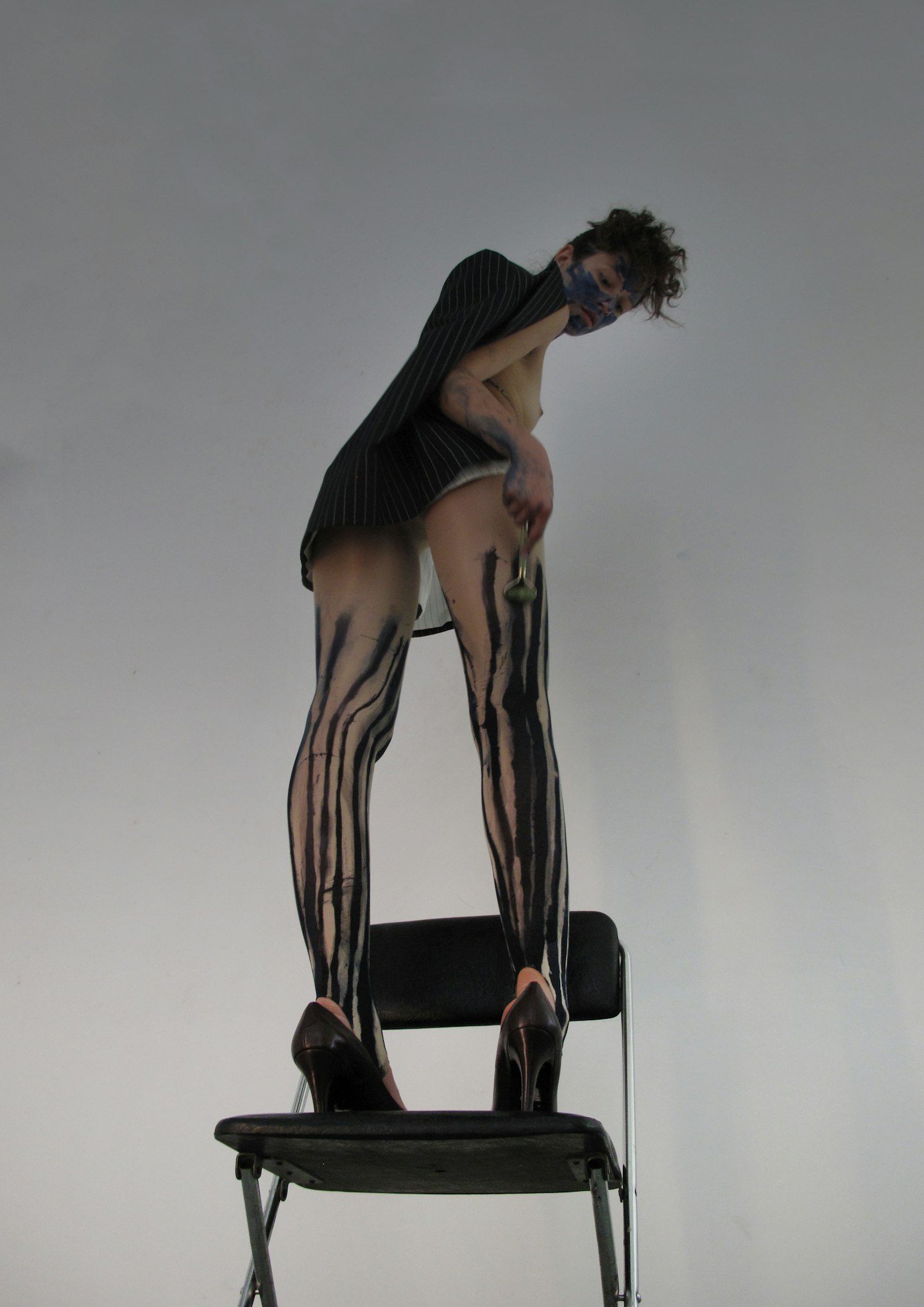 15 of 25
15 of 25Mollie-May Boyd, BA Fashion Design and Marketing
Can you please explain your final collection? My final collection aims to capture the frustration and pressure of maintaining a single work persona inside and outside of work. Today's beauty and living products promote the well-maintained organised lifestyle, urging women to better themselves by making one's life more 'put together' and 'in control.' From jade rollers and metal water bottles to daily horoscope updates, the concept plays on the idea of a lifestyle without these commodities, questioning whether women today would be able to function, without these 'necessities' society deems essential for attaining your better self. With such a reliance on lifestyle products, the concept suggests that when deprived of lifestyle enhancers, consumers regress to childlike behaviour. The behaviours captured range from scribbling on one's hand to wearing overly exaggerated makeup. What has been your biggest inspiration? PJ Harvey's gaze has inspired the female muse, with her opting to inhabit a different persona for each album, suggesting a hybrid woman. Harvey's choice to embrace multiple personalities will be used to encourage a movement. I believe this will boost working women not to opt for a single persona concerning her job title, choosing to neither be dressed or undressed. Intrigued by the over-manufactured world we live in today; the collection plays on the ridiculous idea of a product being over-designed with a product to solve almost any problem and all the problems you didn't realise you had. **Which fashion designers/creatives would you cite as your biggest inspiration?**Currently, I'd have to say Yeezy. After 3 months in lockdown and watching 7 seasons of Keeping up with the Kardashians, I've really come to respect Yeezy as a brand and the world around it has created. What do you think fashion will look like in 10 years? I believe the fashion industry is currently at a turning point but could go in two different directions – either leaning towards escapism where the physicality of clothes is at a high demand becoming more fantastical for the wearer to express their beliefs, or it could go in completely the opposite direction where digital marketing becomes the main focus with consumers buying into a lifestyle and not the product itself. What's been your highlight during your time studying at CSM? It has been a privilege to be constantly surrounded by other creatives that all have their way of thinking in their approach to design. Before understanding my design identity, peers were able to pinpoint it for me, which helped me realise it for myself pushing it further making it more distinguishable.**What's your ambition now you've graduated?**It has been a great few years of winging it and surprising yourself of what you can do without directly studying a skill set. Especially during the lockdown, you were not only designing and sewing garments but you were also having to embrace the role of a photographer, videographer, digital marketer, graphic designer, creative director, stylist etc. I think now is the time to specialise in one aspect and learn the ins and outs, moving more towards digital marketing and strategy.
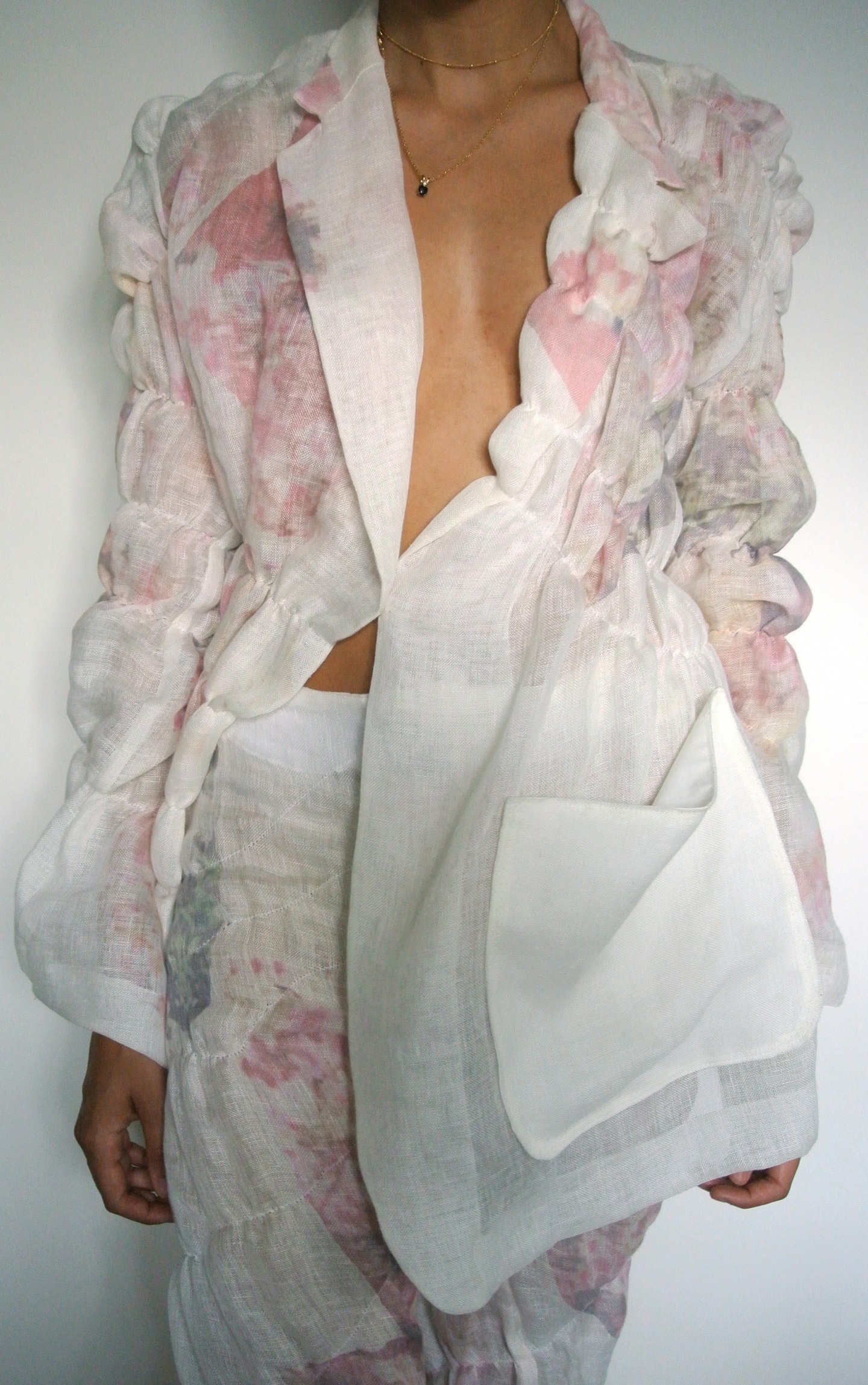 16 of 25
16 of 25Rachel Callender, BA Fashion Menswear
**Can you please explain your final collection?**The collection explores the sentimental attachment I have for memories that are not my own, and times through which I did not live, as preserved in physical objects. Particular focus is placed on my parents and their early lives in the 70's and 80's as documented by photographs, clothes, records and other collections found in my family home.While the physical documentation of these times remain unchanged, conversations with family have shown the attached memories to be anything but. Malleable textile manipulation disrupt both silhouettes and prints to represent the nature of memories, how they can be rendered false or indistinct with the distorting effect of time. **What has been your biggest inspiration?**Silhouettes were informed by photographs of my parents - and of musicians they listened to at the time - how they dressed, the details of their clothing. I looked to Mick Jagger, Marianne Faithful and Miles Davis in particular. Artist Robert Rauschenberg's 'Hoarfrost' series, Louis Bourgeios's 'Ode à l'Oubli' and the sculptures of Constantin Brâncuși were additional influences on my work. **Which fashion designers/creatives would you cite as your biggest inspiration?**I wouldn't be able to cite any currently, as I stopped keeping up to date with fashion collections a good while ago now, and don't want my work to be influenced by other fashion designers. **What do you think fashion will look like in 10 years?**Hopefully a more sustainable industry that has broken away from its current demanding seasonal structure. Fewer shows - if physical showcases are not completely abandoned in the future - perhaps with men's and womenswear collections more widely shown alongside each other than they are currently, or with more fluidity in collections. **What's been your highlight during your time studying at CSM?**The people I have had the privilege to learn from - both tutors and fellow students - has been the highlight of my CSM experience. To be in such an environment as this, where some of the best creative talent can be found, has challenged me to try and be the best that I can. I am in awe of the people in this community and working alongside fellow students in the studio is something I have missed so much because of the coronavirus outbreak.**What's your ambition now you've graduated?**I look forward to continuing to learn, to develop myself and my skills - in whatever form that takes: whether in a job, interning, creating more of my own designs to build upon and evolve my graduate collection, or learning a completely new creative form.
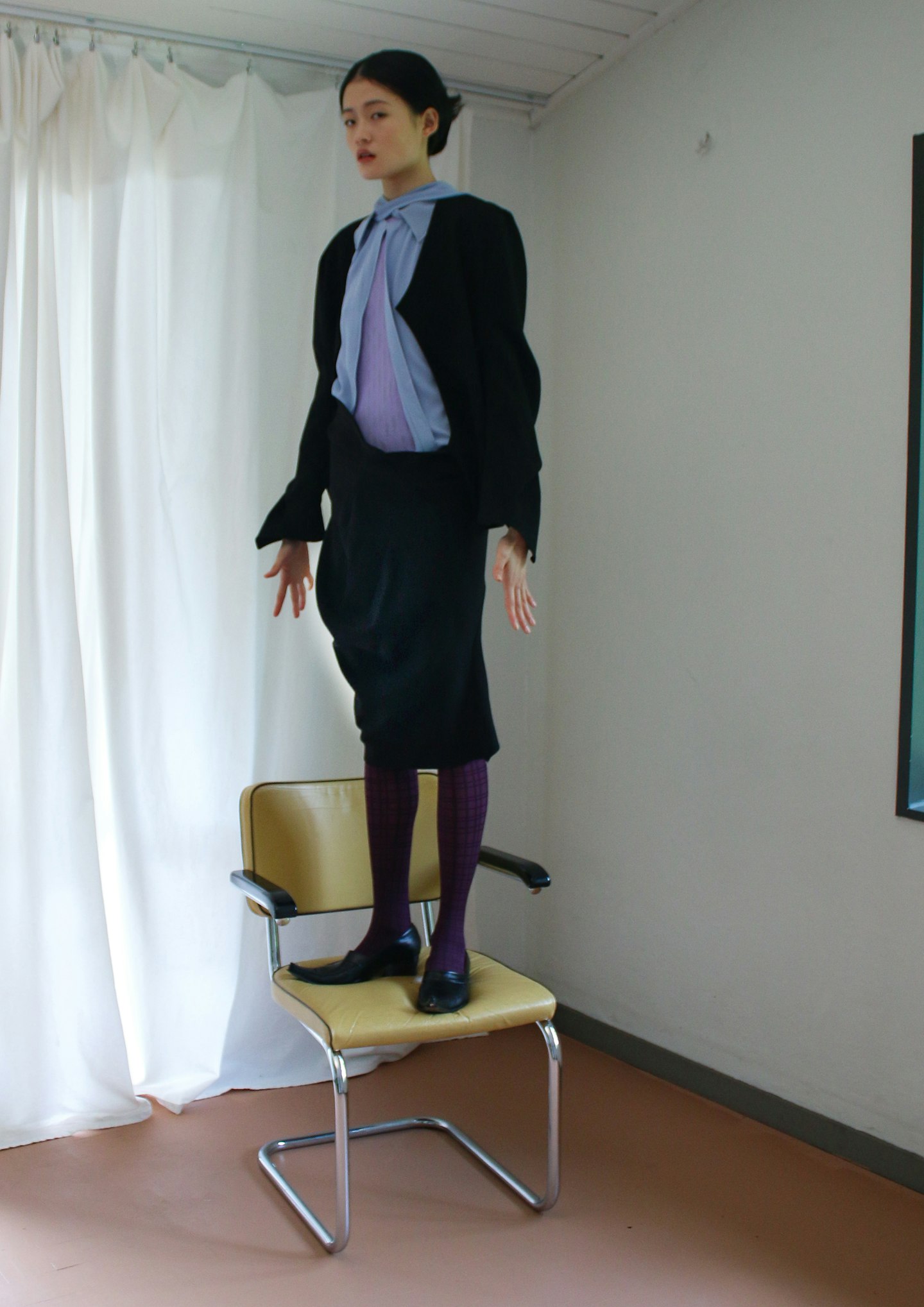 17 of 25
17 of 25Rin Choe, BA Womenswear
**What has been your biggest inspiration for the collection?**My dad is the main source that inspired my collection. It began from his obsession with business golf.**Which fashion designers/creatives would you cite as your biggest inspiration?Yohji Yamamoto and Jun TakahashiWhat do you think fashion will look like in 10 years?**Design-wise, it will evolve constantly and I cannot really imagine how it will be.However, after this pandemic, I think the fashion industry will be changed a lot. We all learnt things from this situation and have been seeing a lot of possibility and abilities from hidden side. I assume that it will be more technically stable and online media could be developed more and more by becoming the biggest platform to show their work.**What's been your highlight during your time studying at CSM?**Learning and respecting each other among students, it was such a huge chance that I could be grown up with amazingly creative people. Just sharing idea each other is just can be another inspiration to me.**What's your ambition now you've graduated?**Observing myself slowly and challenging another work with different types of people. I just started to find my identity as a fashion designer during final year which is really significant. I am very excited to see myself growing up after graduation.
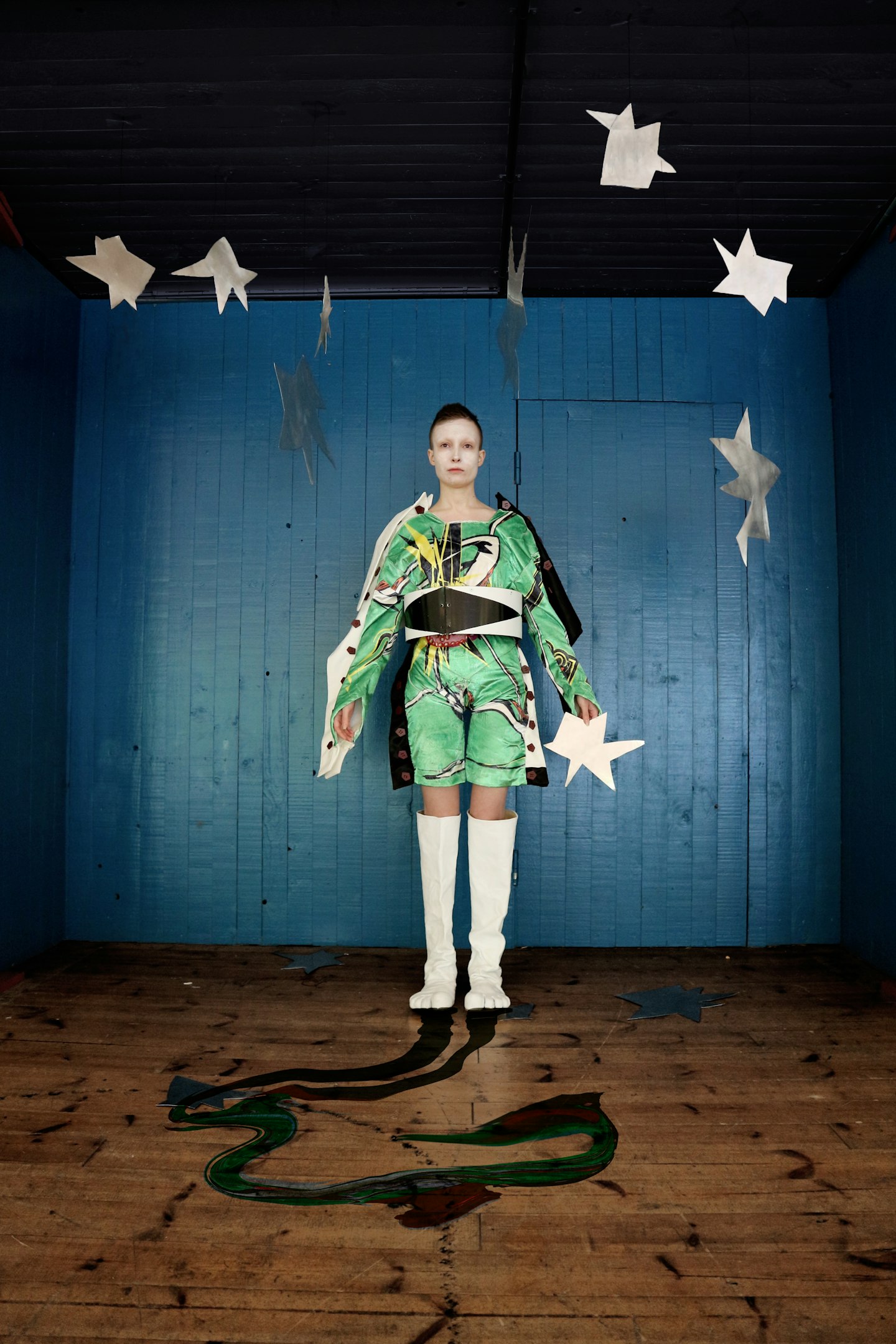 18 of 25
18 of 25Salome Kappelin, BA Womenswear
**Can you please explain your final collection?**At the beginning of the year, I was reading a book on fashion in the 19th Century by C. Willet Cunnington and a line that really stuck with me was this: "The only shape that was forbidden her was that of a woman."Already in kindergarten, the girls with curly hair want to have straight hair and the girls with straight hair want to have curly hair – why is that? Focusing on the 19th century woman and the way she through undergarments achieved the ideal body of the time, I wanted to create a collection questioning why fitting the female body into boxes is so important for us. **What has been your biggest inspiration for the collection?**Being a creative in the world of creation, I never stop to be amazed by nature. I love walking and I can't remember a project when nature hasn't had a part in my creative process. This time light has played a big role. **Which fashion designers/creatives would you cite as your biggest inspiration?**When it comes to my own creating, my biggest inspiration is the creation itself. Otherwise, I really appreciate creatives that seems to fully follow their inner convictions of creativity. One example is when Rei Kawakubo in 1975 opened Dover street Market. **What do you think fashion will look like in 10 years?**Someone once said, if you want to know the future, you need to know the past. I think there is a lot in that. It is obvious that the world doesn't need more clothes, but maybe more than ever, it needs the telling without words. Being a generation of young designers coming forward, it is more important than ever, that we take responsibility for the mess fashion has caused the planet. This, I think can be done in several ways.One, is to remind people about the value of creativity and that overconsumption is caused by the lack of creativity rather than the opposite. Also, to value techniques of making that are almost forgotten. By learning old techniques, reinterpreting these and carrying them forward, I think we can encourage a curiosity to know more about quality and manufacturing of garments, which then can lead to higher demands on the way things are made and who has to suffer in the process. **What's been your highlight during your time studying at CSM?**To share your process of creating is both inwardly impressive and personal. CSM's strength, I think, is the ability of the teachers (in my case Anna-Nicole Ziesche and Heather Sproat) to grasp the uniqueness that exists in each student's creativity and to help bring it forth. A process that has both its highs and lows, still, going through this and doing it as a group with the other students, has been the best!**What's your ambition now you've graduated?**I know I want to continue working creatively, In what form and how, is still in process, but I trust that God will lead the way.
 19 of 25
19 of 25Sam Wellington, BA Womenswear
**Can you please explain your final collection?**Deconstructing the Judeo Christian and polytheistic mythology of the angel through the lens of historical bespoke tailoring techniques. Metamorphosis of the human body into the part-bird chimera. It's also an anthropological study of winged beings through classical culture subverted. **What has been your biggest inspiration?**Post-1860's tailor's manuals, such as "The Ladies Tailor Complete Instructor" by Hughes & Storey from 1892. I also collected and studied skeletons and feathers of birds local to North Yorkshire. **Which fashion designers/creatives would you cite as your biggest inspiration?**Charles James for his acute awareness of aesthetic utility in every seam of his work. And also Madame Grès for her ability to distil cloth into its simplest and most refined form on the female body without restraint. **What do you think fashion will look like in 10 years?**It will be an industry separated by the bipolar cleavage of artisanal techniques and the augmented/digital world. Both will hold intrinsic value for counter-positional reasons. The former will hold value in only what cannot exist in the latter – the sensory experience. **What's been your highlight during your time studying at CSM?**I feel incredibly humbled to have received the Swarovski Foundation Scholarship for my graduate collection. Without their generous support, I would not have been able to materialise my work to the level of complexity in which it now exists. Their contributions meant not only that I could realise my collection in its purest form but also maintain the costs of living in London during lockdown and the consequential economic downturn. **What's your ambition now you've graduated?**To establish my business – Atelier Samuel Wellington in bespoke tailoring from antique salvaged and restored textiles in Harrogate. I also will seek to continually develop contemporary techniques in cutting, structuring and articulating cloth on the body in relation to the musculature and movement of the wearer.
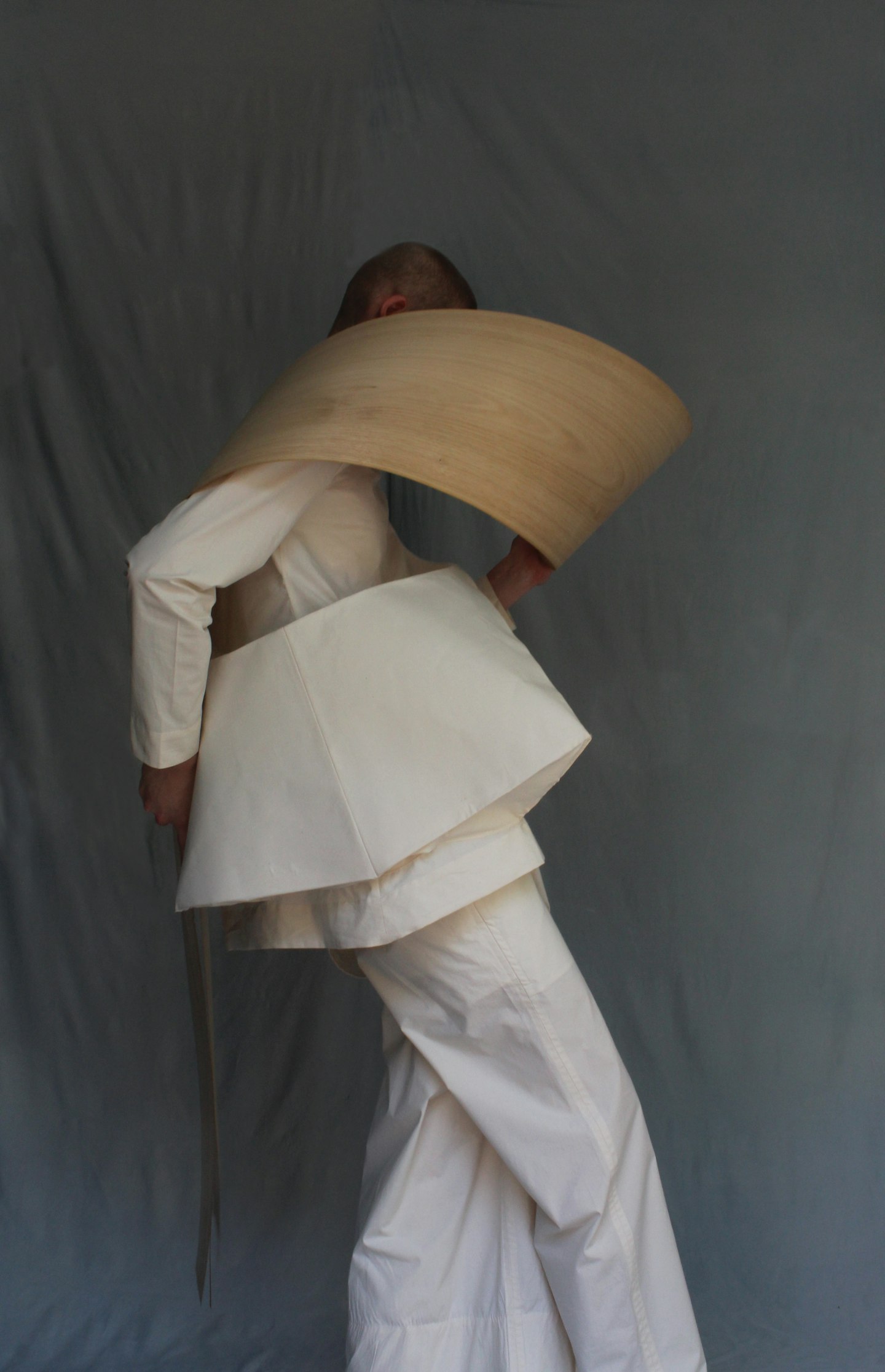 20 of 25
20 of 25Shanti Bell, BA Fashion Print
**Can you please explain your final collection?**Masculinity within society is something that I have always been intrigued by. My collection explores the pressures society places on young males with expectations of obligated ways to respond to life situations. My idea is to visually display the weight and burdens that young men have to carry, through objects we as a society have invented to carry our own weight. I want to present an honest representation that translates young men who are images of strength and stability, proudly showing their vulnerabilities.**What has been your biggest inspiration for the collection?**My inspirations for this collection have been informed by chair and bag designs. I have always had a fascination with chairs and how they can represent a presence or the lack of one. I wanted to research different chair and bag designs, ranging from the historical to the contemporary, and drawing from these references, allowed them to inform my garment design. Another side of my inspiration for this collection was investigating life from the young male perspective which gave me a unique, intimate insight and deeply informed how I went about creating this collection. **Which fashion designers/creatives would you cite as your biggest inspiration?**I am highly inspired by is the Italian designer, Martino Gamper, who created '100 chairs in 100 days' through repurposing and dissembling old chairs. This was a project I found fascinating as Gamper's approach to the design process was by learning and responding from the chair he made previously, to inform the next. Christo and Jeanne-Claude are two artists whose work, I feel, added a much-needed drama and large scale presence into the world. The scale in which they work and how they encompass so much of their surroundings, I find to be incredibly impactful, especially how their works reached and involved such a large audience. They had a particular process and I found their choices of materiality, colour and locations to be highly precise and distinctly appropriate. **What do you think fashion will look like in 10 years?**What I hope is that it is reflective of the progressive mindsets and ideas of its generation. I think fashion will be a direct response to what the world is about in that current time and be even more of a platform to inform and cultivate its audience. I think with fashion, boundaries are always being pushed in terms of ideas, materials, and the crossing over of mediums, and I am constantly surprised and excited by what young designers are introducing. I think the unpredictable and unexpected will become the new normality.**What's been your highlight during your time studying at CSM?**The growth in knowledge, ideas, techniques, and experience has been so vast. To look back on work I had done in my first year compared to my current collection and following that visual diary, has allowed me to recognise that being a creative is a learning process and when nurtured, you can produce exciting results. Also, being surrounded by likeminded creatives, not only within my class but across all the different mediums taught at CSM, has not only been inspiring but taught me such alternative perspectives. What's your ambition now you've graduated? I am currently moving into a studio that I have just started to rent and my goals are to start working towards putting on a creative exhibition alongside fellow students. I am planning to revisit elements of my collection which had to put on hold and produce another response to my collection concept. I also plan to enhance my furniture chair making, to start to further develop a relationship and blend with the world of fashion and furniture..
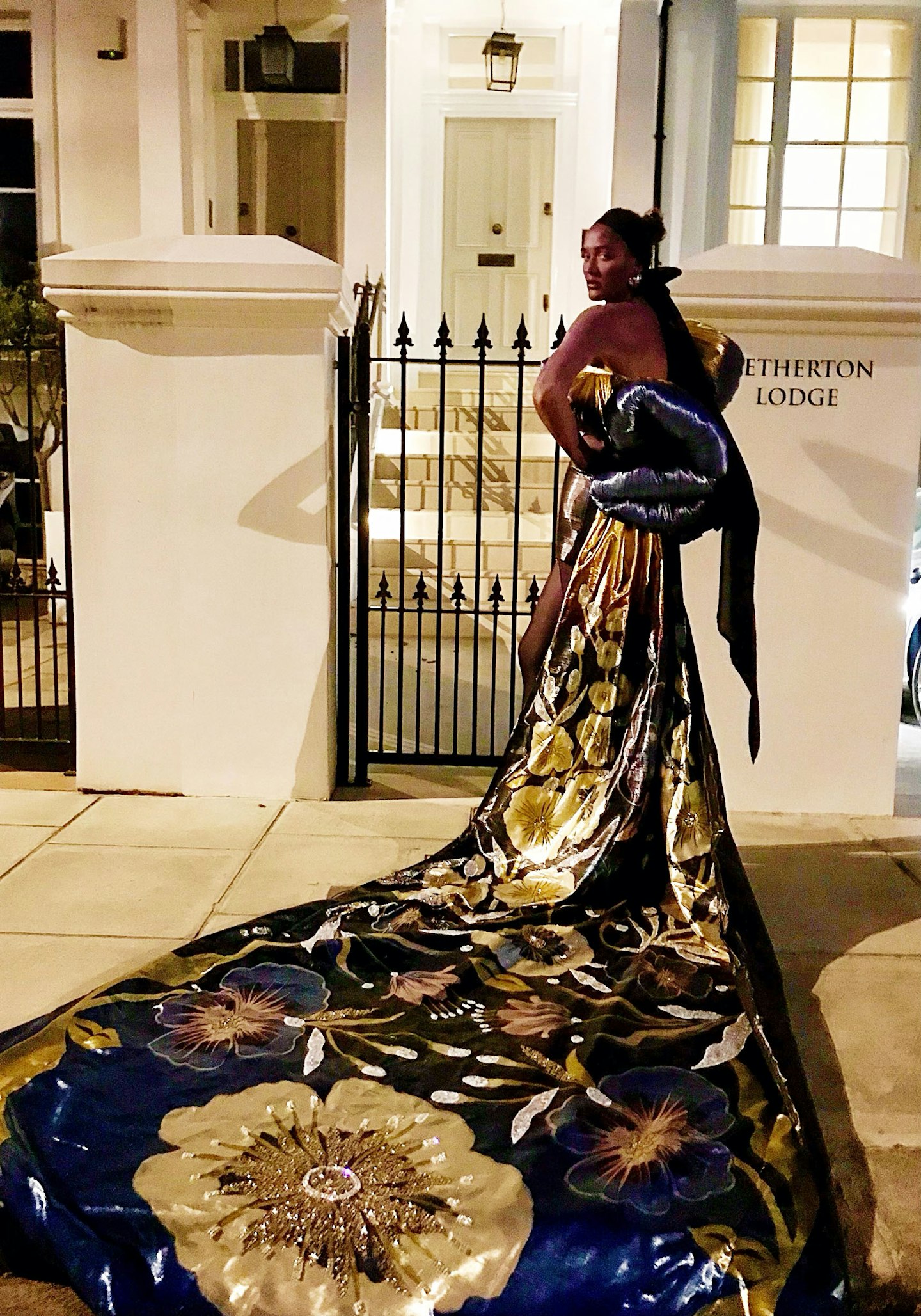 21 of 25
21 of 25Sohee Park, BA Fashion Design and Marketing
What Is your final collection about? A romantic, glamorous world exploding with floral fantasies. **What has been your biggest inspiration for the collection?**I have been an illustrator from a young age. The purple woman featured in my paintings was my muse for this collection. She is a depiction of myself, evolving as a woman living in an exotic world. Moving to London at an early age, everything seemed foreign to me. I never felt a sense of belonging, which often led me to feel like an alien. But don't we all share in that feeling at times? At the end of the day, we all miss home. But for me, and for others, I imagine, the question remains, 'Where is home?' That feeling of loneliness often made me look for escape. For me, fashion was that escape and it became "home" for me. The feeling of wearing couture, the highest form of wearable luxury, is like walking on a cloud. I wanted to share that with the world through my designs and illustrations. As a little girl, I often found myself daydreaming, as if I were trapped in a beautiful universe in my own mind. It was a romantic, glamorous world exploding with floral fantasies, with beautiful, elegant women walking down streets in gorgeous gowns with their pink and purple poodles in tow. I would say, then, that the making of this project has been a lifelong process. What's been the highlight during your studies at CSM? Definitely finishing my graduate collection in the midst of a pandemic. Creating this collection has been a really tough journey. As soon as I finished developing my final toiles, the country went under lockdown. With a few days notice, I was forced to move five substantial dresses into my small apartment. I even had to hang some from the ceiling, as there was simply not enough room! The experience moulded me into a versatile designer that can create a collection of couture gowns in a small space with little but a domestic sewing machine and a needle and thread.What do you think fashion would look like in 10 years? I see a great shift to everything going online. I imagine there won't be a great demand for physical shops or malls and many designers will choose to showcase their work online during fashion week. Having said that, I think 2020 is de years?finitely a practice for the industry to slow down and think. With my own show being cancelled and as I was sewing up my dresses in my apartment preparing for a virtual showcase, it made me wonder: Is travelling for numerous shows season by season that necessary? What's your ambition now that you have graduated? I want to see women wearing my designs on the streets, on dates, or even at work. Now that my debut collection has finished, I am currently working on my ready-to-wear collection that is to be launched soon. I want to launch my brand online and have it incorporate the qualities of couture into RTW. When every little detail of a garment harmonises as a whole, that is couture. When careful design and countless amount of thought is put into a single design, that is couture. Two years ago, my designs were shared by Diet Prada after an incident where other designers were producing and selling replicas of my designs. Until this day, I see girls posting selfies on social media wearing my designs. At the time, I was in my second year of university, and I was not in any way prepared to deal with something that I had not anticipated at all. However, it taught me that my designs had a strong commercial value and motivated me to start my own business after my studies. Having said that, I would also love to work at a fashion house where I could contribute my talents into making beautiful collections. What I enjoy most about being a fashion designer is seeing the positive responses to my designs. I see so many people reposting and sharing my work on social media. I love sharing my designs and aesthetic with the world. Designing is what I love doing, and I see myself doing it throughout my life.
 22 of 25
22 of 25Stevie Hunter, BA Womenswear
Can you please explain your final collection? My final collection is based upon the indistinct memories we all have of high school. I looked to break down these memories through separate characters and personalities, studying how these characters from days past have effected the way we carry ourselves today. **What has been your biggest inspiration?**The fact that the majority of my family all attended the same school within a 40/45 year span - my grandmother, my mother, my sister and myself all attended the same primary and high school. I found this really intriguing as we all had teachers that overlapped our time there, however we seen them in varying different ways. Which fashion designers/creatives would you site as your biggest inspiration? I often cite the work of fine artists as my biggest inspiration. Artists such as Joesph Beuys, Katharine Grosse, John Balldessari, and Douglas Gordon to name a few. I find their practice a lot more freeing and easier to connect with, their intentions are a lot clearer, which is maybe to do to with the slower pace they work at, in comparison to fashion. What do you think fashion will look like in 10 years? Hopefully there will be a return to craft and concept, and a move away from profit driven product being championed as the next best thing we all need. I hope, just like art, fashion slows down to a snail's pace, shows will only be shown when they need to be shown, ideas will only need to be had, when there is a valid idea to be had. Hopefully. What's been the highlight during your time studying at CSM? I think my highlight has been the first moments I walked past the gates into the school, receiving my first brief, and my first timetable. The idea that I managed to somehow sneak my way into such a pace like Central Saint Martins was amazing! What are your ambitions now you've graduated? To find a JOB!
 23 of 25
23 of 25Taya Louise Badgley, BA Womenswear
**Can you explain your collection?**This collection is inspired by the women who historically and presently cultivate the soil and tend the Earth. It is a celebration and honouring of their spirit. Made from natural fibres, and focusing on Organic Cotton, British wool and deadstock. I've come to realize that this body of work, is my way of expressing gratitude for the Earth that sustains us, and honouring Nature that surrounds us. What's been your main inspiration?The starting point and main inspiration of the work is the soil. Reconnecting to the Earth below us, and the Nature that surrounds us. I see the soil as substance. The substance of life. The substance of the Earth. And the women, who have worked, and continue to work the land. The guardiennes of the Earth. Garment inspiration was drawn from 19th and 18th century peasant dresses, as well as workwear from the 1900's to the 1930's (particularly photographer Dorothea Lange documentation of the Dustbowl). Which fashion designers or creatives have inspired you the most? Some of the creatives I look to are Madeleine Vionnet, of course Rei Kawakubo, Dorothea Lange, Julia Margaret Cameron and Annie Leibovitz. Rebecca Burges, founder of Fibershed, is also someone I look to for inspiration. She is amazing, and pioneering regenerative fibre and carbon farming practicesWhat do you think fashion will look like in ten years? No one knows what tomorrow holds...especially now. So, I think we all must use this time (and we are!) to reflect and change as individuals. Use what we've learned and experienced internally to transform externally. The future of fashion isn't determined, in fact, we've been given once in a lifetime chance to create something totally new. We have the chance to decide what industry, what world we want to create, live in, contribute to. We are all being asked individually and collectively to go deep and reflect and really look at what we value as human beings....and the extent to which we do this, and take action will determine the future. It's already determining our present. I do think that sustainable, environmental and ethically focused fashion will become even more important. It already has with COVID-19. Prioritizing buying less and caring for what we already have more. Supporting diversity in fashion and supporting smaller, ethical, environmentally conscious brands and makers. Putting the health of the planet at the top of the list. Growing material in ways that positively contribute to soil health and the biosphere, such as Climate Beneficial Wool. Looking to nature and the Earth as a guide forward, rather than sticking with the old systems. What are your ambitions now you have graduated? I have many ambitions and goals for the future. I see my future as a mix of sustainably focused fashion, costume design and creating impactful imagery. Going forward in fashion, either working for an environmentally conscious label, or starting my own company and studio practice. I want to use fashion, costume and imagery in ways that is of service in some way. Work that makes us feel and heal and re-connect.Additionally, during these past months, I've found how much I genuinely enjoy creating visuals through photography and moving imagery, I intend on continuing to develop this practice. Currently, I'm starting to work on a project focusing on wool, specifically traceable wool from organic and holistically managed, native breed (such as Shetland) flocks in the UK. Wool is an amazing, yet undervalued regenerative fibre. I spent part of placement year on a sheep farm in Somerset and it's my ambition to collaborate with British sheep farmers, to support English wool and start a label making beautiful, quality, climate beneficial knitwear.
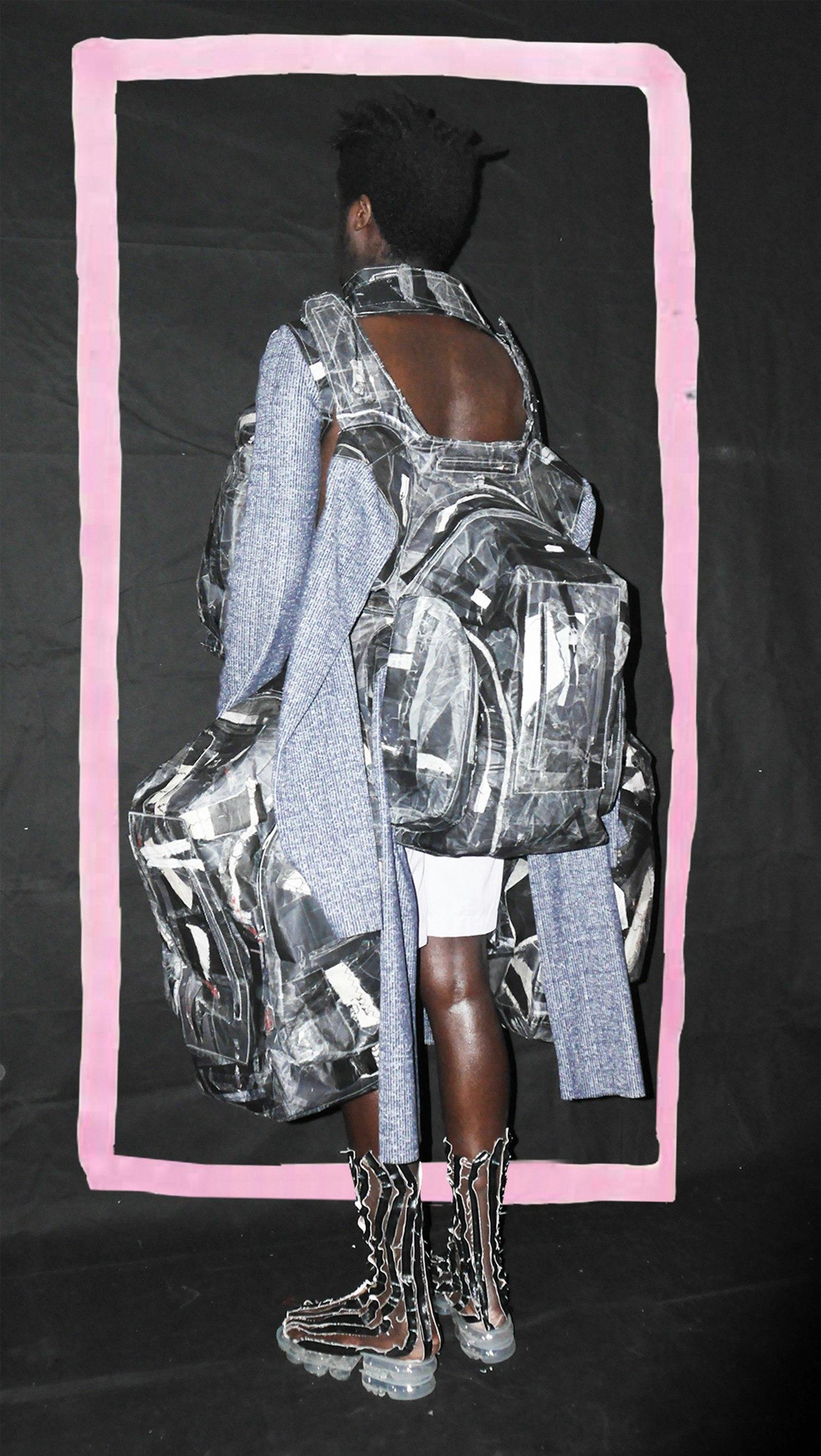 24 of 25
24 of 25Violette Villeneuve, BA Womenswear
**Can you please explain your final collection?**I focused on the idea of the internal experiences we collect through life. I wanted to transmit the raw energy of the essence of self which is constituted by lots of different pieces, and that we should let ourselves go. This is represented through prints and intertwining lines, a back-heavy silhouette symbolising the painful and cherished experiences we carry and through cutting, collaging, re-joining, laminating recycled and repurposed materials.**What has been your biggest inspiration for the collection?**With this collection, my hope was always that fashion slows down drastically. I only used waste and existing materials. The artwork of punk album covers inspired the colours and overall attitude of the collection, specifically The Cramps, The Cure and Keith Flint from The Prodigy.**Which fashion designers/creatives would you cite as your biggest inspiration?**I more often use Fine Arts reference rather than Fashion references. But doing an internship at Rick Owens, in Paris, has definitely shaped my conception of design. He and his team developed a full "world": combining painting, sculpture, architecture and fashion. I'm incredibly thankful to the Rick Owens team to have allowed me to be a tiny part of their journey. **What do you think fashion will look like in 10 years?**To be honest, I don't know how it would look like in 10 years. Even if a little revolution is happening, it is hard to see if everyone involved is willing to evolve. I HOPE that in 10 years time, fast fashion will be dead. We don't need any companies from more developed countries to exploit the population of the countries in development. I truly hope that within 10 years, fashion will stop being a part of this modern slavery. With the lockdown, we have learned that the world is able to slow down. We always say that we can't stop. But we actually stopped and it was OK.**What's been your highlight during your time studying at CSM?**When I left Paris four years ago, my city wasn't as open creatively as London was. And it was extraordinary to be able to let myself go creatively and learn that you can express yourself without any limits at CSM. I've met incredible individuals. We've been pushing each other further constantly and it is the most precious experience. **What's your ambition now you've graduated?**I hope to get into a Fashion MA, because I know that I have more to learn and that I still need to gain in maturity, design-wise. Obviously, I would love to find a job straight after the BA, but I am worried that with the lockdown and its impact on the fashion industry, it is not an option for most brands to hire right now... Let's see!
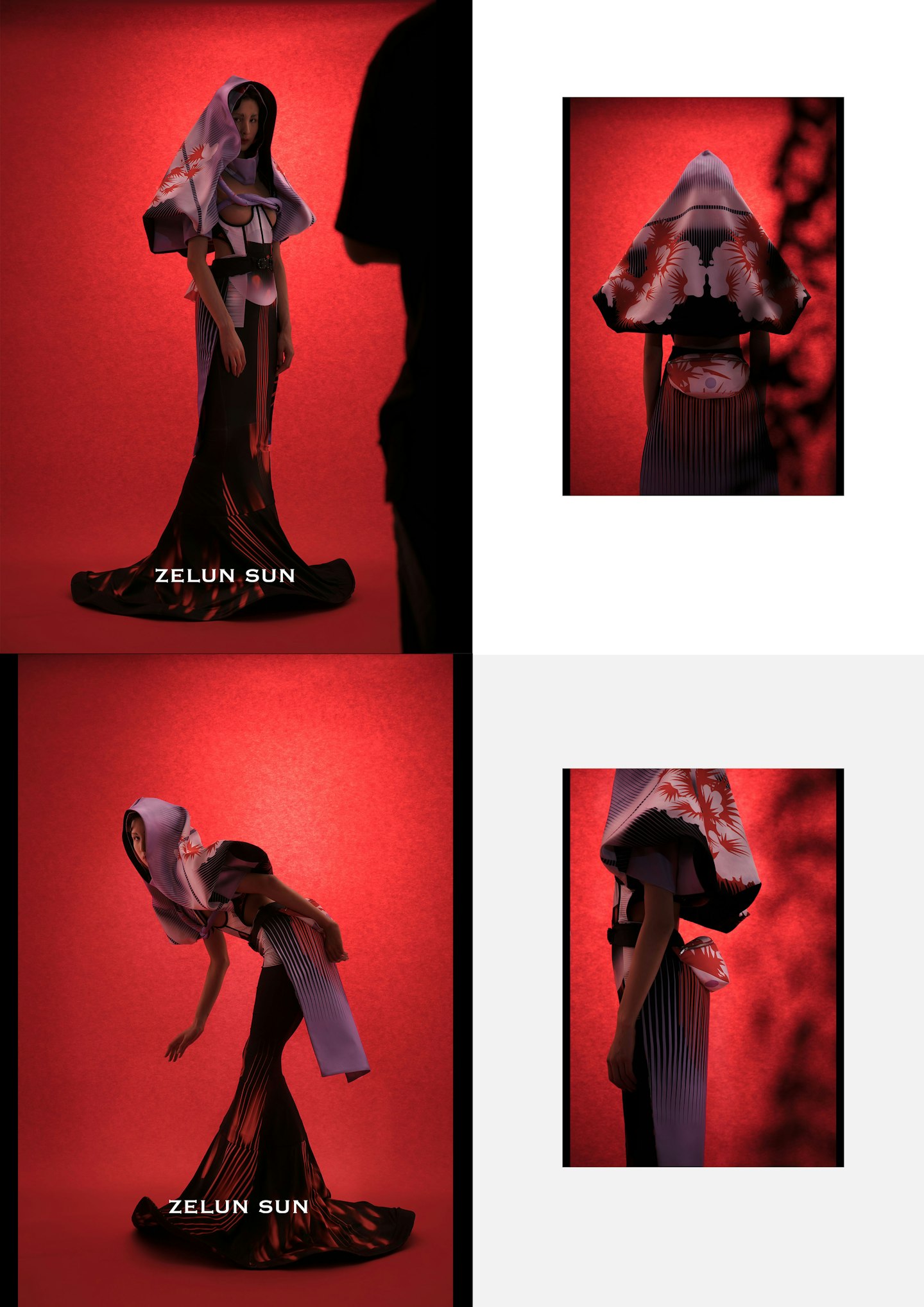 25 of 25
25 of 25Zelun Sun, BA Womenswear
**Can you please explain your final collection?**The contemporary world is a huge space for argument, in which we are no longer pure beings, being influenced by voices and cultures. The ubiquity of the Internet and social media highly enriched our visual information. In contrast, we live in a world with more information with less meaning. This collection hopes to reconstruct the connotation and extension of "human" through the discussion of "virtual body". **What has been your biggest inspiration?**I found out that internal and external relations, instead of being a fixed and singular opposition, are mutually replaceable. For example, the lining of clothes tends to be ignored, but I believe that lining could also be visible. Humans beings are unstable creatures like an item of clothing that is inside out. Therefore, I used scrapped clothes and metal plates to design a coat whose small shard is rotatable. One side of it used the scrapped clothes that recorded the past or memories of people around me, which to some extent represents a person and is in line with my theme. As for the other side, I used three different textures of silver cloth for the bottom, and silk-screen printing was adopted for adding patterns of digital information. The patterns with different textures on both sides manifested my understanding of the virtual body and the reality. To complete the piece, I worked for around 264 hours with more than 3,000 shards. Moreover, both hard and soft fabrics were adopted. Hard materials and soft materials produce contrast. But I'm also very curious about how they collaborate while playing to their individual strengths. This is also consistent with my theme of "contradiction and identity". **What do you think fashion will look like in 10 years?**Technological advances tend to optimize the functionality of clothing. For the younger generation, the demand for clothing is something more of self-expression. What we have been pursuing is the latest technology, but fashion repeats itself, including the prevalence of vintage and the renovation of the 80s and 90s styles. This phenomenon suggests that while enjoying the convenience brought by technology, we still want to revisit the spiritual world a particular past era represented. **What's been your highlight during your time studying at CSM?**It is an atmosphere. When you come to the fashion studio and see that everyone is busy creating "beauty", you are lured to work hard to bring something to this world, and you believe that you can. **What's your ambition now you've graduated?**Many of the artists I admire are following geniuses on Instagram, and I look forward to cooperating with the creators of different fields. The coronavirus outbreak has brought tremendous changes to the whole fashion industry, and I, as a student majoring in fashion who is about to graduate, take them as opportunities and challenges. The unknown contains endless possibilities to which I'm confident. Honestly, I still have a lot of intriguing designs and thoughts to share after the graduation project, and I'd try to fulfil them in the future. Full preparations are needed to establish a personal brand, for which I need sufficient talents, financial inputs, and widespread support. Instead of eying on a speedy creation of brand, I'd look at a long-term plan of brand operations. Having a personal brand is my earliest dream and ultimate goal, and I'm now focusing on every detail to win the focus and support from various platforms and media.
